文章
巴黎铁塔
2017年05月26日
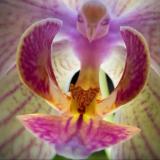

#麒麟掌 叶黄之温度
麒麟掌并不耐寒,10月中旬霜降之前最好就移至室内,而且温度也不能太低,最好是15℃以上,这样才能保证叶子不会发黄,要是室温低于12℃就可能导致叶片干枯了,所以温度很重要,一定不要太低,当然温度太高也是不可取的。
麒麟掌叶黄之光照
麒麟掌喜欢光照充足的环境,在生长季节里一定要给予充分的光照,不一定非要在室内长期的观赏;冬季为了维持基本的生命活动还需要进行光合作用,所以也要保证阳光的供给,否则时间久了叶片很容易变黄脱落。

麒麟掌叶黄之水分
麒麟掌还是挺耐干旱的,所以平时浇水一定要注意,记得遵循宁干勿湿的原则哦。当彻底干透的时候再进行浇水,浇透。冬天要控制浇水,浇水过多也会导致黄叶的。
麒麟掌叶黄之肥料
麒麟掌对肥料并不怎么有好感,遵循宁少勿多,宁淡勿浓的原则。上盆时可以上些基肥,比如一些粉碎的固体肥,施肥时避免生肥、浓肥,不然导致落叶就不好了。冬季就要停止施肥了,等立春开始生长的时候在逐渐回复正常的供肥。

0
0
文章
素雅
2017年05月26日


第一步.播种育苗
备土:将准备好的营养土放进花盆,距离盆边3~4厘米。浇透水,等土壤稍干后,播种。
种植前将种子放在50~55℃的温水中浸泡10~12小时,取出后直接播种与花盆中。10~15厘米播一粒种子。
播种之后,在表面覆盖上后0.5厘米的泥土,盖上一层塑料薄膜,等小苗长出后解开薄膜。

第二步.入 盆
当西红柿的幼苗长出3~4片叶子时,就可以定植上盆了。
首先将花盆洗净,将在盆底小孔堵住,然后装入沙土。
将小苗挖出,注意不要伤到根系,小苗根部保留少量泥土,直接栽种到花盆中,将植株扶正,随即浇水,直到盆孔有水渗出。

第三步.日常管理
水分管理
西红柿种植时浇一次水,浇透,之后3~5天浇一次水。结果之前控制浇水,结果后要保持盆土湿润。
施肥管理
上盆后10天浇一次肥水,在开花之前施入腐熟的鸡粪。
打杈
所谓的打岔就是将刚长出的嫩芽适当摘除,促进开花结果。
整枝
整枝后通常有两种状态,单干枝或双干枝两种。
单干整枝
只有一个主干,将其他侧枝全部剪掉。这样的植株结果数量较少,但果实较大。
双干整枝
有两个主干,其他全部摘除。这样可增加结果数量,但要保证植株的养分供应,否则果实会变态生长。
修剪
当株型高于80厘米时,要打顶。将顶端的叶片摘除。
果实过多时要及时疏花疏果,西红柿植株的茎并非木质,承载重量有限,结果过多会不堪重负倒伏,为保证果实的质量及果形,必须要蔬果熟花。
第四步.开花坐果
1)正常花序开花花序的位置离植株顶端20厘米左右;开花的花序以上有显蕾的花序和正在发育的花序;花序生长紧凑,花梗粗短而壮;开放的花朵肥大,花色浓而鲜艳。徒长花序:开花不整齐,往往花器及子房特大,花瓣色浓黄色。老化花序:开花延迟,花器小,花瓣淡黄色,子房小。正常花:同一花序内开花整齐,花器大小中等,花瓣黄色,子房大小适中。
弱花:花蕾瘦小,花梗纤细,是由于高温,光照不足,或营养缺乏所至。
(2)正常株茎粗细均匀适当,节间长度由下向上逐渐增大,各个小叶较大,略似掌状,叶身大,叶脉清晰,叶片先端较尖,果实膨大期后正常的植株呈塔形;生长点部位和下面正在发育伸长的叶片构成一个近似等边三角形。
(3)营养生长过旺的营养生长形态上部茎较粗,顶端嫩叶弯曲,顶芽和下面的新叶构成不等边三角形,小叶叶柄较长。
(4)极端生殖生长形态开花节位上移到顶端附近,茎细叶片小,植株顶端呈水平形,是由于低温干燥缺肥所至。
(5)花序返青形态花序顶端又长出新叶或新稍,是由于高温、低温、干燥、氮肥过多所至。
第五步.果实成熟期
(1)绿果期(青果期)果实已充分长大,果实的体积停止膨大,细胞个数和体积不再增加,果实的生理活动全为物质转化,果色由绿变白,种子发育基本完成,具备发芽和生产能力。一般长途运销或贮藏的番茄应在此期采收。 (2)转色期(拉红线期)果实顶端逐渐着色,达到全果的1/4,采收后在适温下1-2天,即可全部着色。一般从产地运到市场的距离较近时应在此期采收。
(3)成熟期(食用期或商品期)果实已呈现品种的特有色泽,营养价值高,风味较好,适于生吃不耐贮运。一般就近采摘销售方可在此期采收。
(4)晚熟期果实全面变红或黄色,果肉变软,含糖量很高,可生吃,但不耐运输,作为商品已有困难。一般留种,方可在此时才收。
0
3
文章
家里的二哈爱吃花
2017年05月26日


#牡丹花 常见病害一:叶斑病
叶斑病主要危害牡丹花的叶片和嫩枝。发病一般在花后的15天左右,7月中旬最为严重。初期叶片的背面会出现谷粒大的黑色斑点,边缘发黑,病斑逐渐相连,导致叶片枯焦凋落。
解决方法:做好预防,在花落之后,及时喷洒波尔多液,10~15天喷洒一次,一直持续到7月底。可以避免叶斑病的发生。发病时,喷洒甲基托布津、多菌灵溶液,7~10天喷洒一次,连续喷洒3~4次。

牡丹花常见病害二:黄叶病
牡丹花黄叶病主要是因为植物缺少磷导致的,表现为,植株生长矮小,叶片发黄,从茎基部老叶开始,自下而上,逐渐脱落。
解决方法:及时补充养分,花谢之后对叶片喷洒磷酸二氢钾或者微肥。

牡丹花常见病害三:菌核病
菌核病又叫作茎腐病,主要危害根茎造成其腐烂。发病时茎上出现水渍状的病斑,土壤表面出现白色的棉状物。严重时会危害花蕾和叶片。
解决方法:做好消毒工作,在种植植株之前对土壤消毒,干燥后种植,养护期间避免土壤过于潮湿,以免滋生细菌。植株发病时,将植株挖出,消毒后重新栽种。对腐烂较为严重的,可以直接扔掉了。

牡丹花常见病害四:紫纹羽病
紫纹羽病是一种真菌性病害,主要危害根颈和根。受害部分会出现紫色或者白色的絮状物,边缘发黑。轻者会形成片状的斑块,根不生长,枝条枯瘦叶片发黄,严重时植株死亡。此病多发生在6~8月,9月之后随着温度的降低,降雨的减少,逐渐减轻。
解决方法:注意养护环境的整洁,避免环境滋生细菌。在高温多雨的天气,要减少浇水,经常通风。对于受害植株,可在土壤表面撒上石灰或硫磺消毒,严重时,脱盆重新栽种。
0
0
文章
快看我
2017年05月25日

1、期换水,以水培容器内水稍变混浊为换水原则。一般情况下,春秋季每隔10~15天换水一次;夏季的更换周期为5天左右;冬季时每30天更换一次。
2、每次更换水时,要先用清水洗净水培花卉的根部及水培容器,并用湿布擦拭叶片上的灰尘,保持叶片清洁,修剪枯枝败叶及烂根。
3、在换水时,每升清水(以凉开水、山泉水、磁化水等水源为佳,若用自来水则需要澄清6小时以上)添加4瓶盖水培营养液,并摇匀即可用于水培花卉。
4、在加水时,要求浸入水中的花卉根系数量不超过1/2,其余的根系留在水培容器空气中,并尽可能的保持根系自然下垂;日后可适时摇动一下水培容器中的水。
5、注意保持通风,要求摆放的场所有一定的空气湿度。如空气湿度不够,则可向空气中喷洒雾状清水,增加空气湿度。平时可向叶片喷洒少量雾状清水,或者用湿布擦拭花卉叶片,保持叶片清洁无灰尘。
6、水培花卉一般可摆放于办公室、会议室、大厅、茶几、电脑旁、厨房、卧室、客厅、卫生间等室内环境中,摆放时尽可能的置于室内阳光较为充足的地方(即向阳处,散射光较多),但要避免阳光直射和寒风吹打。
7、室内温度宜控制在8℃~30℃间。若温度过高则可采取空调制冷、喷水、水帘冷却等手段适当降温,同时一定要加强通风;而在冬季里应注意保温越冬,经常接受散射光或太阳光直接照射,如遇到极端低温时可采用取暖器来增加环境温度,也可以用较厚实的透明塑料袋将水培花卉从上至下罩实,并在塑料袋上开3~4个孔利于透气,并防止冷风吹。
8、平时若发现水培花卉出现腐烂根则应及时彻底清除。即先用干净的枝剪将腐烂根从根基处一次性剪掉;然后对根部采用0.5%的高锰酸钾进行消毒处理10分钟,并用清水冲洗干净,其后用清水(或磁化水)采取定植篮固定悬浮水养7~15天,每两天换水一次,待长出新的水生根后可以添加适量营养液正常水培了。
9、若有条件的话,还有在水培营养液中添加1%的过氧化氢(即3%双氧水),或者添加0.1%的高锰酸钾,以利于释放氧气或抑制水中有害菌藻滋生;当然也可以在水培营养液中添加少量的微生物菌肥或活性炭,改善水质,使之更利于植物根系吸收。
10、根据个人爱好可在水培容器中放养少量金鱼、水草等水生生物,并可添加七彩玩石以增强其观赏性。
2、每次更换水时,要先用清水洗净水培花卉的根部及水培容器,并用湿布擦拭叶片上的灰尘,保持叶片清洁,修剪枯枝败叶及烂根。
3、在换水时,每升清水(以凉开水、山泉水、磁化水等水源为佳,若用自来水则需要澄清6小时以上)添加4瓶盖水培营养液,并摇匀即可用于水培花卉。
4、在加水时,要求浸入水中的花卉根系数量不超过1/2,其余的根系留在水培容器空气中,并尽可能的保持根系自然下垂;日后可适时摇动一下水培容器中的水。
5、注意保持通风,要求摆放的场所有一定的空气湿度。如空气湿度不够,则可向空气中喷洒雾状清水,增加空气湿度。平时可向叶片喷洒少量雾状清水,或者用湿布擦拭花卉叶片,保持叶片清洁无灰尘。
6、水培花卉一般可摆放于办公室、会议室、大厅、茶几、电脑旁、厨房、卧室、客厅、卫生间等室内环境中,摆放时尽可能的置于室内阳光较为充足的地方(即向阳处,散射光较多),但要避免阳光直射和寒风吹打。
7、室内温度宜控制在8℃~30℃间。若温度过高则可采取空调制冷、喷水、水帘冷却等手段适当降温,同时一定要加强通风;而在冬季里应注意保温越冬,经常接受散射光或太阳光直接照射,如遇到极端低温时可采用取暖器来增加环境温度,也可以用较厚实的透明塑料袋将水培花卉从上至下罩实,并在塑料袋上开3~4个孔利于透气,并防止冷风吹。
8、平时若发现水培花卉出现腐烂根则应及时彻底清除。即先用干净的枝剪将腐烂根从根基处一次性剪掉;然后对根部采用0.5%的高锰酸钾进行消毒处理10分钟,并用清水冲洗干净,其后用清水(或磁化水)采取定植篮固定悬浮水养7~15天,每两天换水一次,待长出新的水生根后可以添加适量营养液正常水培了。
9、若有条件的话,还有在水培营养液中添加1%的过氧化氢(即3%双氧水),或者添加0.1%的高锰酸钾,以利于释放氧气或抑制水中有害菌藻滋生;当然也可以在水培营养液中添加少量的微生物菌肥或活性炭,改善水质,使之更利于植物根系吸收。
10、根据个人爱好可在水培容器中放养少量金鱼、水草等水生生物,并可添加七彩玩石以增强其观赏性。
0
1
文章
柠檬加盐
2017年05月25日

要使春节后盆花来年继续开花,要根据该花的生长习性,做好盆花的养护处理。现把几种花卉春节后的栽培处理介绍如下:
蝴蝶兰应在花朵凋谢后将花梗整枝从基部剪除,最好放置在15℃以上的室内和靠近窗边光亮处。天热时要注意遮荫50%和维持在20~30℃的环境下,天冷时要注意保持温度在10℃以上,并要减少浇水,花芽出现后要暂停施肥,直至再度开花后方可施肥。
大花蕙兰花基本凋谢,就立即将花梗从基部剪除,把在室内摆放多时的盆栽植株移至阳台半荫处,在寒冷地区要移至室内靠近窗口处,切记温度应维持3~5℃以上,将病叶剪除,每周用百菌清或托布律500倍液喷洒植株,一般喷3~4次可达到防治目的。
春石斛应及时把残留的花梗从基部剪掉,并将开过花的植株移至室外阳台半荫处放置。这些老茎在花后一般会在基部长出新芽。有新芽和新根出现证明新的生长已经开始,此时要加强水肥管理,给予充足的光照,以培育出粗大的新肉质茎。
观赏凤梨的花期较长,一般在2~3个月后花序才会失色老化。此时可将其花序剪除,以利于基部吸芽的萌生。这些吸芽可让其依附在老株的基部生长,直至老株死亡而由吸芽长大的新植株取而代之。但是这些由吸芽长大的植株要经历几年后才能开花,要想其来年开花几乎是不可能的事。
猪笼草节后1个月左右就要将其移至靠近窗口的室内光亮处,保持室温在15℃以上,不要被寒风吹袭。如果室内湿度过低,就要设法增湿,可定期多次喷水或将盆栽植株放于鱼缸边,也可整盆套入透明塑料袋中保湿和盆面铺上一层湿透水的水苔来增湿。总之,保持高温高湿以及光照充足的环境是其继续存活的关键。
蝴蝶兰应在花朵凋谢后将花梗整枝从基部剪除,最好放置在15℃以上的室内和靠近窗边光亮处。天热时要注意遮荫50%和维持在20~30℃的环境下,天冷时要注意保持温度在10℃以上,并要减少浇水,花芽出现后要暂停施肥,直至再度开花后方可施肥。
大花蕙兰花基本凋谢,就立即将花梗从基部剪除,把在室内摆放多时的盆栽植株移至阳台半荫处,在寒冷地区要移至室内靠近窗口处,切记温度应维持3~5℃以上,将病叶剪除,每周用百菌清或托布律500倍液喷洒植株,一般喷3~4次可达到防治目的。
春石斛应及时把残留的花梗从基部剪掉,并将开过花的植株移至室外阳台半荫处放置。这些老茎在花后一般会在基部长出新芽。有新芽和新根出现证明新的生长已经开始,此时要加强水肥管理,给予充足的光照,以培育出粗大的新肉质茎。
观赏凤梨的花期较长,一般在2~3个月后花序才会失色老化。此时可将其花序剪除,以利于基部吸芽的萌生。这些吸芽可让其依附在老株的基部生长,直至老株死亡而由吸芽长大的新植株取而代之。但是这些由吸芽长大的植株要经历几年后才能开花,要想其来年开花几乎是不可能的事。
猪笼草节后1个月左右就要将其移至靠近窗口的室内光亮处,保持室温在15℃以上,不要被寒风吹袭。如果室内湿度过低,就要设法增湿,可定期多次喷水或将盆栽植株放于鱼缸边,也可整盆套入透明塑料袋中保湿和盆面铺上一层湿透水的水苔来增湿。总之,保持高温高湿以及光照充足的环境是其继续存活的关键。
0
0
文章
后果的大树
2017年05月25日

#紫茉莉可春播繁衍,也能自播繁衍,通常用种子繁殖。以小坚果为播种繁殖材料,可于4月中下旬直播于露地,发芽适温15℃至20℃,七八天萌发。因属深根性花卉,不宜在露地苗床上播种后移栽。如有条件可事先播入内径10厘米的筒盆,成苗后脱盆定植。用种子繁殖,宜在3-4月播种育苗,苗长出2-4片叶子时定植,株距50-80厘米为宜。移植后注意遮荫。紫茉莉管理粗放,容易生长,注意适当施肥、浇水即可。紫茉莉为风媒授粉花卉,不同品种极易杂交,若要保持品种特性,应隔离栽培。
紫茉莉栽培管理简便,早春播种,夏秋季开花结实。耐移栽,生长快,健壮。长江以南作多年生栽培。华北多作一年生栽培,或于秋末将老根掘起,置于5℃室内越冬,翌春植露地仍可下午盛开至次日清晨凋谢。紫茉莉生性强健,适应性强,养护管理粗放。
在栽培中注意:
①繁殖。紫茉莉常用种子繁殖,可在春季直播露地,出苗后注意间苗;也可先育苗,当苗长出3-4片真叶时,移栽定植,株距约50厘米,移栽后注意适当遮荫与浇水。
②养护管理。紫茉莉生长容易,养护管理较为粗放,在生长期间适当施肥、
③采集种子。由于紫茉莉是风媒授粉,品种间极易杂交,为了保证采收的种子能保持优良特性,应将不同品种进行隔离栽培。
紫茉莉喜欢温暖的气候,土壤要求疏松,肥沃、深厚,含腐殖质丰富的壤土成夹砂土较好。紫茉莉日常管理比较简单,晴天傍晚喷些水,每周傍晚追施稀薄肥1-2次,有利正常生长。病虫害较少,天气干燥易长蚜虫,平时注意保湿可预防蚜虫。把它栽培在花圃、庭院中,多年来未发现病虫害。日常管理比较简单,晴天傍晚喷些水,每周傍晚追施稀薄肥1-2次,有利正常生长。栽培在花圃、庭院中,多年来未发现病虫害。
紫茉莉根为褐色的块根,形似山石,是一种很好的树桩盆景材料。紫茉莉块根会逐年膨大,3年便可长成直径10厘米左右,且能培养数十年,随着栽培时间的增长,块根越显得苍劲。在栽培中应注意越冬和种植。紫茉莉在长江以南地区可露地过冬。在北方则要在秋末之际,将紫茉莉的根挖出埋在盆中湿土中,放置室内,翌年春季再栽培。将紫茉莉根下部1/4种植在浅盆中,其余裸露,在正常的养护管理下就能发根、生长、开花。

紫茉莉栽培管理简便,早春播种,夏秋季开花结实。耐移栽,生长快,健壮。长江以南作多年生栽培。华北多作一年生栽培,或于秋末将老根掘起,置于5℃室内越冬,翌春植露地仍可下午盛开至次日清晨凋谢。紫茉莉生性强健,适应性强,养护管理粗放。
在栽培中注意:
①繁殖。紫茉莉常用种子繁殖,可在春季直播露地,出苗后注意间苗;也可先育苗,当苗长出3-4片真叶时,移栽定植,株距约50厘米,移栽后注意适当遮荫与浇水。
②养护管理。紫茉莉生长容易,养护管理较为粗放,在生长期间适当施肥、
③采集种子。由于紫茉莉是风媒授粉,品种间极易杂交,为了保证采收的种子能保持优良特性,应将不同品种进行隔离栽培。
紫茉莉喜欢温暖的气候,土壤要求疏松,肥沃、深厚,含腐殖质丰富的壤土成夹砂土较好。紫茉莉日常管理比较简单,晴天傍晚喷些水,每周傍晚追施稀薄肥1-2次,有利正常生长。病虫害较少,天气干燥易长蚜虫,平时注意保湿可预防蚜虫。把它栽培在花圃、庭院中,多年来未发现病虫害。日常管理比较简单,晴天傍晚喷些水,每周傍晚追施稀薄肥1-2次,有利正常生长。栽培在花圃、庭院中,多年来未发现病虫害。
紫茉莉根为褐色的块根,形似山石,是一种很好的树桩盆景材料。紫茉莉块根会逐年膨大,3年便可长成直径10厘米左右,且能培养数十年,随着栽培时间的增长,块根越显得苍劲。在栽培中应注意越冬和种植。紫茉莉在长江以南地区可露地过冬。在北方则要在秋末之际,将紫茉莉的根挖出埋在盆中湿土中,放置室内,翌年春季再栽培。将紫茉莉根下部1/4种植在浅盆中,其余裸露,在正常的养护管理下就能发根、生长、开花。

0
1
文章
美琪爱拍照
2017年05月24日

#发财树 又名马拉巴栗,是木棉科瓜栗属多年生常绿乔木,原产中美洲,在我国广东、海南、福建等地可露地栽培。发财树最适生长温度是15℃至30℃,喜温暖、湿润的环境,对光照要求不严,喜光但也有一定的耐阴性,室内散射光即可生长良好。栽培基质以富含腐殖质的偏酸性沙壤土为好,可用腐叶土、泥炭加适量河沙混合而成。
发财树有一定的耐旱性,生长期保持土壤湿润可以促进生长,三四天浇水一次即可。冬季要控制浇水,土壤稍微干燥即可。其对肥料要求不高,生长旺季可适当施肥,以氮肥为主,冬季不施肥。
发财树常见的病害有根腐病和叶枯病。一般环境阴湿易造成根腐病,发病多从根或根茎部开始,往上蔓延,韧皮部软腐成水浸状,木质部变色。应为植株营造合适的环境条件,保持干爽清洁。发病后,可用普力克或锌锰灭达乐喷洒治疗。
叶枯病主要发生在叶片的边缘,发病初期叶边缘有褐色小斑点,逐渐向内扩展形成枯叶斑,与健康部位有明显的交界线。发病后期,病斑上密生很多小黑点,影响观赏效果。发现病叶后应及时摘除,同时在栽培过程中加强管理,适时浇水施肥,生长季节喷施叶面肥,也可喷施多菌灵、百菌清等药剂。
虫害主要是蔗扁蛾。入冬时防治,可用好年冬1000倍液浇灌茎部受害处,并用3%呋喃丹混入栽培基质中。每隔10天一次,连续两三次,可将越冬的蔗扁蛾幼虫杀死。如果病株受伤严重,要及时烧毁。
发财树有一定的耐旱性,生长期保持土壤湿润可以促进生长,三四天浇水一次即可。冬季要控制浇水,土壤稍微干燥即可。其对肥料要求不高,生长旺季可适当施肥,以氮肥为主,冬季不施肥。
发财树常见的病害有根腐病和叶枯病。一般环境阴湿易造成根腐病,发病多从根或根茎部开始,往上蔓延,韧皮部软腐成水浸状,木质部变色。应为植株营造合适的环境条件,保持干爽清洁。发病后,可用普力克或锌锰灭达乐喷洒治疗。
叶枯病主要发生在叶片的边缘,发病初期叶边缘有褐色小斑点,逐渐向内扩展形成枯叶斑,与健康部位有明显的交界线。发病后期,病斑上密生很多小黑点,影响观赏效果。发现病叶后应及时摘除,同时在栽培过程中加强管理,适时浇水施肥,生长季节喷施叶面肥,也可喷施多菌灵、百菌清等药剂。
虫害主要是蔗扁蛾。入冬时防治,可用好年冬1000倍液浇灌茎部受害处,并用3%呋喃丹混入栽培基质中。每隔10天一次,连续两三次,可将越冬的蔗扁蛾幼虫杀死。如果病株受伤严重,要及时烧毁。
0
0
文章
柠檬加盐
2017年05月24日

开花后的君子兰,如果盆过小,并长有子株的,可以通过换盆换土,进行分株繁殖。已经结子的,暂缓翻盆换土,待到初冬时将种子采后再翻盆换土。君子兰结子后可每隔10~15天施1次稀薄的复合肥,促使其继续长叶和种子饱满。但切忌施入浓肥或生肥,否则不仅叶尖会发黄,而且已结成的种子也会脱落。同时,应放在通风、凉爽而半阴的地方,防止烈日照射或直接淋雨水,盆土宜稍偏干为好,切忌土壤过湿。
0
0
文章
笼岛 みどり
2017年05月23日


花の都フィレンツェの公園で行われるフラワーマーケットをご紹介します

フィレンツェ駅からバスで10~15分ぐらいで到着。
私が訪れたのは数年前ですが、いつでも地元の人たちで大賑わいです。
公園を散歩しながら苗を物色・・・よそ見をしていると踏み付けてしまいそうなぐらい所狭しとカラフルな苗が陳列されます。


公園内にはシンボリックな宮殿型の温室がありますが、マーケットの時は存在感が薄れるほどです。


私好みのカラーリーフもたくさん!

売っているのはペチュニアのハンギング、でも自転車オブジェも欲しくなりますね

黄と紫のミックスレイアウト、素敵でつい手が伸びてしまいます・・・

ハーブの香りに手招きされて辿り着いたのはバジルのカーペット!

日本とはちょっと仕立て方が違うけれどモミジ専門店です

1
0
文章
爱狗爱花爱小刚
2017年05月23日
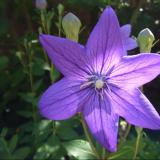
一、穴盘育苗
第一阶段:胚根萌发至子叶出现温度为15℃至21℃时,7至12天可出芽。基质中保持较低的EC值,pH值为6.0至6.5。播种前应对栽培基质进行杀菌消毒。播种后覆盖蛭石、沙粒或栽培基质。要求土壤保持湿润但不能过于潮湿。高温会抑制发芽。
第二阶段:子叶生长至第一对真叶出现
此阶段需适当降低土壤湿度,但是穴盘仍不能过于干燥,同时需将温度降低至15℃至17℃。EC值不能高于0.75。可开始施用可溶性氮肥,浓度为50ppm至75ppm。
第三阶段、第四阶段:真叶生长、发育阶段及炼苗阶段
这两个阶段的施肥浓度可增加到100ppm至150ppm。炼苗后应及时上盆。
二、栽培管理
1.移植上盆萌芽后3至4周,可用9至10厘米口径的花盆进行移植,切花植株的间距以15至25厘米×15至25厘米为宜,且需用网状物保持茎干的直立。
2.介质栽培基质需排水良好,基质中泥土含量为20%至30%,每立方米基质中施加1至1.5千克的完全平衡肥、2千克以内的缓释肥、铁螯合物、微量营养元素,pH值为6.0至6.5。使用经过消毒的基质和栽培器皿,可预防镰刀菌及黄萎病的产生。
田间栽培:可用排水良好且养分水平中等的沙质壤土。合理的施肥为每平方米基质喷施80至100克的缓释肥。温室栽培前需对介质进行杀菌消毒。
3.光照属长日照植物。长日照会促进植株开花,提高植株品质和增强分枝性。光照不足会抑制植株开花和生长。对于切花品种,在幼苗时期至少需要4周的光照时间,每天的光照时数在14至16小时。在短日照的自然条件下要进行补光。夜间需中断补光(4小时)。花蕾出现后可缩短光照时间,会促进花朵开放且缩短栽培时间。如果植株只在短日照的条件下生长,叶片会出现簇状化,影响正常的开花。
4.温度生育适温为12℃至15℃。翠菊无法在8℃以下的温度条件中生长,不耐霜冻。在生育适温的范围内,温度越低,植株的性状表现越好,但开花时间会稍微延长。低温短日照将影响植株的生长。
5.肥料管理需肥量中等。可喷施浓度为100ppm至150ppm的氮钾平衡肥(N:K2O比例为1:1.5),每周一次。避免高铵和高氮水平。含氮量过高将导致茎干徒长。为了防止镁和铁元素的缺乏,可分别喷施浓度为0.025%的硫化镁1至2次,及铁螯合物1至2次。
第一阶段:胚根萌发至子叶出现温度为15℃至21℃时,7至12天可出芽。基质中保持较低的EC值,pH值为6.0至6.5。播种前应对栽培基质进行杀菌消毒。播种后覆盖蛭石、沙粒或栽培基质。要求土壤保持湿润但不能过于潮湿。高温会抑制发芽。
第二阶段:子叶生长至第一对真叶出现
此阶段需适当降低土壤湿度,但是穴盘仍不能过于干燥,同时需将温度降低至15℃至17℃。EC值不能高于0.75。可开始施用可溶性氮肥,浓度为50ppm至75ppm。
第三阶段、第四阶段:真叶生长、发育阶段及炼苗阶段
这两个阶段的施肥浓度可增加到100ppm至150ppm。炼苗后应及时上盆。
二、栽培管理
1.移植上盆萌芽后3至4周,可用9至10厘米口径的花盆进行移植,切花植株的间距以15至25厘米×15至25厘米为宜,且需用网状物保持茎干的直立。
2.介质栽培基质需排水良好,基质中泥土含量为20%至30%,每立方米基质中施加1至1.5千克的完全平衡肥、2千克以内的缓释肥、铁螯合物、微量营养元素,pH值为6.0至6.5。使用经过消毒的基质和栽培器皿,可预防镰刀菌及黄萎病的产生。
田间栽培:可用排水良好且养分水平中等的沙质壤土。合理的施肥为每平方米基质喷施80至100克的缓释肥。温室栽培前需对介质进行杀菌消毒。
3.光照属长日照植物。长日照会促进植株开花,提高植株品质和增强分枝性。光照不足会抑制植株开花和生长。对于切花品种,在幼苗时期至少需要4周的光照时间,每天的光照时数在14至16小时。在短日照的自然条件下要进行补光。夜间需中断补光(4小时)。花蕾出现后可缩短光照时间,会促进花朵开放且缩短栽培时间。如果植株只在短日照的条件下生长,叶片会出现簇状化,影响正常的开花。
4.温度生育适温为12℃至15℃。翠菊无法在8℃以下的温度条件中生长,不耐霜冻。在生育适温的范围内,温度越低,植株的性状表现越好,但开花时间会稍微延长。低温短日照将影响植株的生长。
5.肥料管理需肥量中等。可喷施浓度为100ppm至150ppm的氮钾平衡肥(N:K2O比例为1:1.5),每周一次。避免高铵和高氮水平。含氮量过高将导致茎干徒长。为了防止镁和铁元素的缺乏,可分别喷施浓度为0.025%的硫化镁1至2次,及铁螯合物1至2次。
0
0
文章
爱狗爱花爱小刚
2017年05月23日

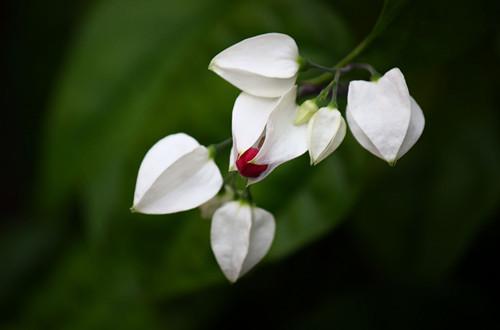
#龙吐珠 为常绿马鞭草科灌木,喜温暖、湿润和阳光充足的半阴环境,不耐寒。越冬温度应在15℃以上,长期低于10℃,可引起落叶至死亡。龙吐珠的生长适温为18~24℃, 开花期的温度宜较低,约在17℃左右。花期5月至11月,要使龙吐珠早开花、多开花,应注意以下几个环节。
1、换土:龙吐珠冬季落叶进入冬眠,翻盆换土在春季萌动前通过换土增加营养,促进长新梢。
2、施肥:在换土同时施足多元素花肥,无土栽培换水加入花卉营养液。施肥应根内、根外结合,根外可用花卉营养液喷洒枝叶,通过施肥,促进生长。
3、浇水:春季换土施肥后要浇足水,无土栽培半月加水一次,有土栽培晴天每两天浇水一次。
4、光照:龙吐珠是短日照植物,即当日照侮天低于一定时间,并持续一段时间后,龙吐珠才能开花。要想使龙吐珠一早开花,就要对其进行遮光,经过10一12周处理就可开花。反之,在日照缩短时每天补光,龙吐珠就会推迟开花。
5、防治病虫害:龙吐珠在换土后应进行喷洒农药,每月喷一次,时间在上午10时前、下午3时后进行,中午烈日不宜喷射,如未发现病虫害也要喷射,做到防重于治。
6、摘心:由于换土后水、肥适应,新梢长得快,通过一个多月生长后要进行摘心,以促进花芽早分化和提早长花蕾,如4月份摘心,“ 五一”开花。实践证明,要使龙吐珠早开花、多开花,必须及时摘心疏芽,去掉枯枝败叶。
7、花期管理:龙吐珠开花时,不能浇多水,更不能浇水于花朵,暴雨时应把龙吐珠移入室内,防止水分增多而导致提前落花,缩短花期。花经25天左右就凋谢,花凋谢后应从花枝头剪去,同时施肥,让下一代花接着盛开。还可用花卉营养液注射龙吐珠嫩枝枝头,促进开花。
0
0
文章
Colorful
2017年05月23日
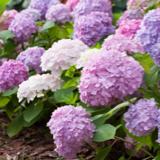
New to growing plants and no idea what you should grow indoors? Learn about these 15 Best Houseplants for Beginners. They all are easy to grow!
Potted houseplants provide a lavish look and can be used to decorate the interior at low cost. Also, they create positive impact and many of them purify the air. But what you’ll do if you don’t have much knowledge about growing plants and the houseplants that are best to grow? Simple! Learn about these 15 Best Houseplants for Beginners! They are easy to grow and tolerate poor conditions.
1. Snake Plant
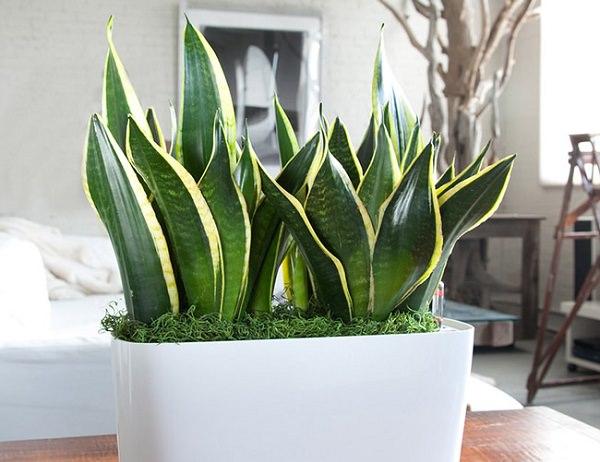
Snake plant is one of the best plants for the beginners. Easy to grow and hard to kill, it can be grown in low light and need to be watered occasionally. Snake plant also removes toxins from the air– All this makes it a perfect houseplant for beginners.
2. Heartleaf Philodendron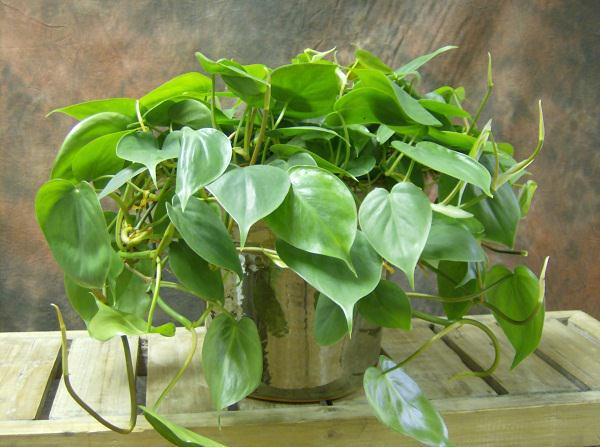
Philodendron scandens is extremely easy to grow and great for beginners. It needs a moderate amount of light and prefers the soil to dry out between watering spells.
3. Spider Plant
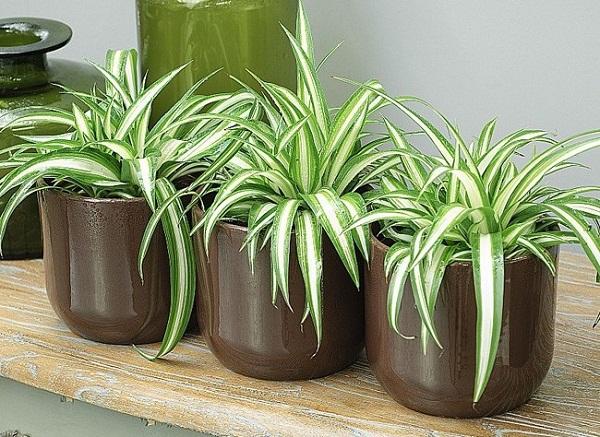
One of the most popular houseplants. Its popularity is due to its toughness and the ease of growing and maintenance. The plant can easily adapt to almost any condition. Keep the plant in a bright spot and maintain slight moisture in the soil and it will grow happily.
4. Peace Lily

The peace lily is among the easiest plants to grow indoors. It can tolerate a wide range of lighting conditions, and needs only moderate watering. With graceful curving leaves and white flower that rise up from the dark foliage, peace lily looks exotic and elegant.
5. English Ivy
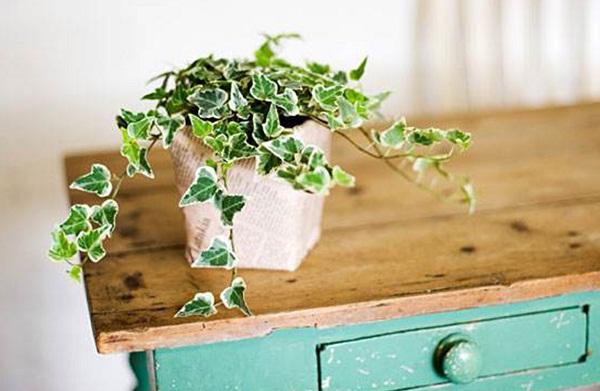
English Ivy is very hardy and easy to grow. Keep the pot in a spot that receives bright indirect sun and plant it in a container that is wide and shallow rather than narrow and deep.
6. Succulents and Cactus

Succulents and cacti are ideal for those who forget to water and care for plants. They are very adaptable and can survive many adverse conditions.
They need to be placed on a bright spot and a well-drained soil with little water.
7. Lucky Bamboo
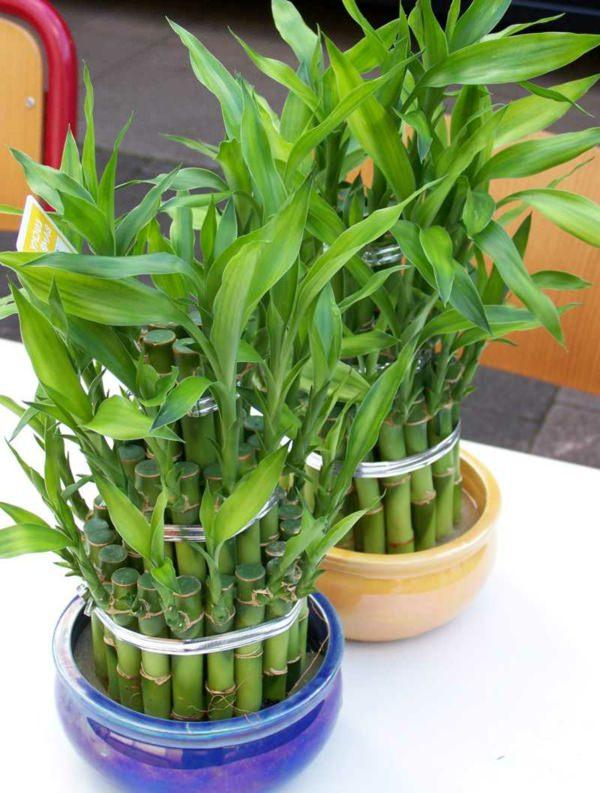
Lucky bamboo is not a bamboo, but a plant belongs to Dracaena genus. It is an easy-care houseplant. Just provide it abundant water and it’ll grow well even in indirect light. Protect the plant from cold drafts and provide iron fertilizer occasionally.
8. Jade Plant
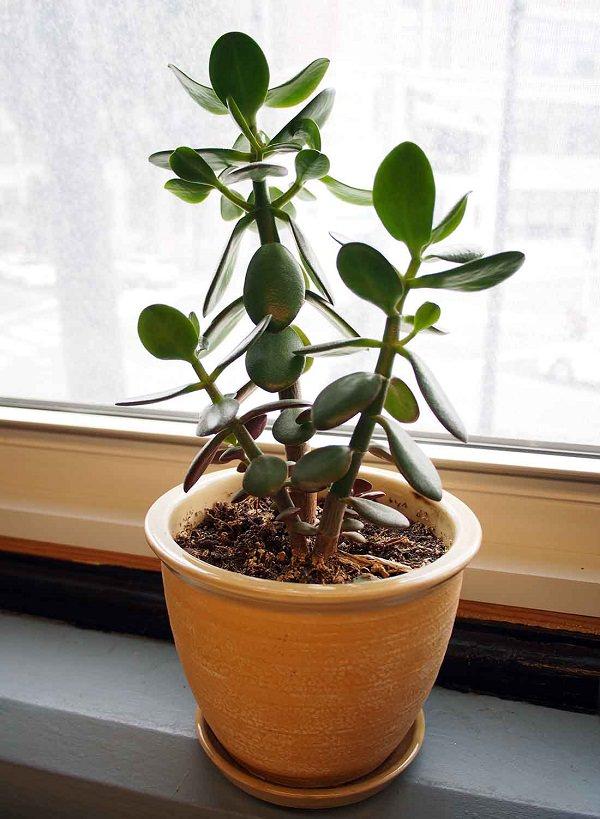
Jade plant is a succulent and is probably one of the best houseplants for beginners. When grown indoors, a jade plant can grow up to a size of a small shrub. Keep the plant in a spot that receives partial or indirect sunlight from having a healthy specimen.
9. Cast Iron Plant
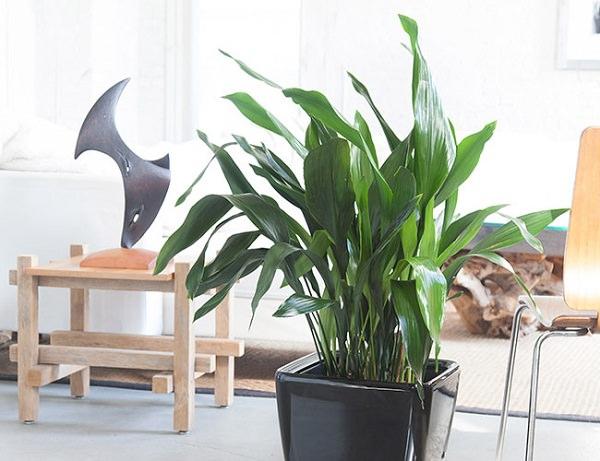
As the name suggest, one of the toughest plants that make it ideal for beginners. Cast-iron plant can withstands neglect, low light, low humidity, and a wide range of temperatures. It prefers moist soil.
10. Peperomia

Credit: Houseplants Expert
Another good plant for beginners is Peperomia. Peperomia is small striking houseplant that is available in different colors and shapes. Peperomia likes slightly moist soil and humidity but watering should be reduced in winter.
11. ZZ Plant
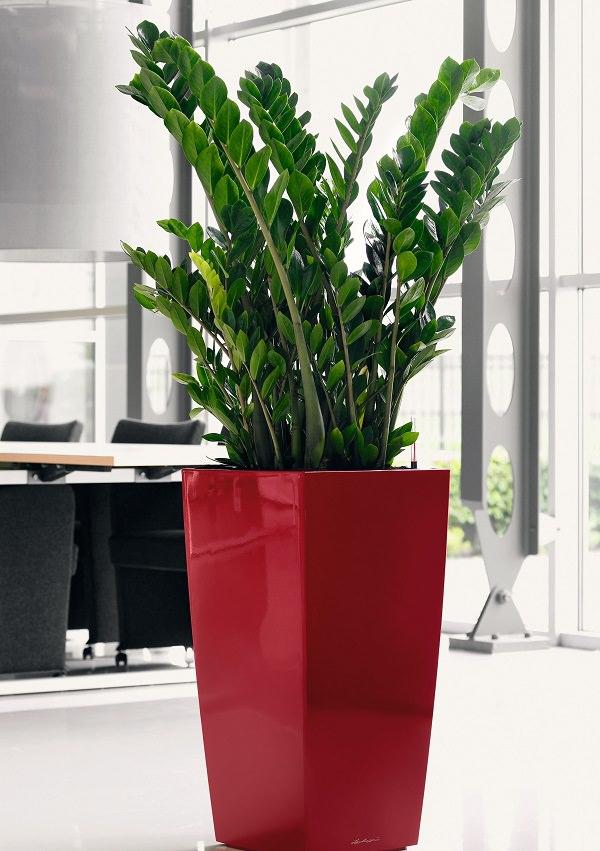
This super-tough plant is high resistant to adverse conditions like drought and low light. The plant prefers bright to moderate indirect light and well-drained soil. ZZ plant can do fine without fertilizer, but if you would like, you can fertilize the plant with half strength general fertilizer one to two times a year in the summer months.
12. Pothos (Devil’s Ivy)
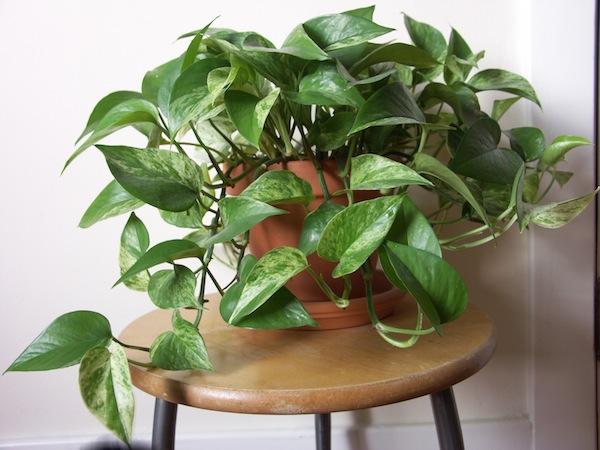
Plants of the pothos family are easy to grow and become great houseplants for beginners. This attractive and durable vine prefers bright indirect light and a draft free place. It can grow in low light and needs moist soil.
13. Dracaena
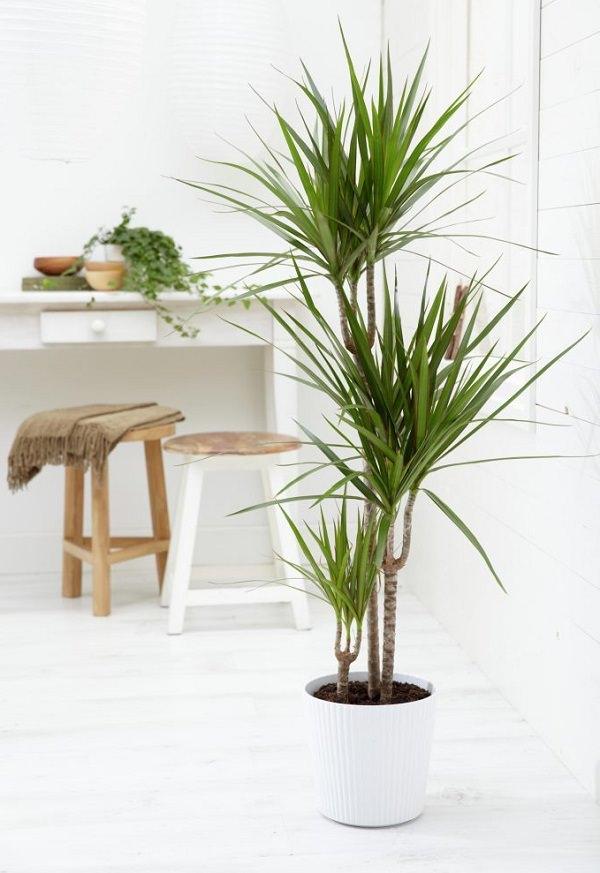
There are many varieties of Dracaena genus that are hardy houseplants, Dracaena marginata, Dracaena fragrans are among the most popular and easy to grow plants. This beautiful houseplant needs occasional pruning and regular watering. Keep the plant away from direct sun and avoid overwatering.
14. Bromeliads
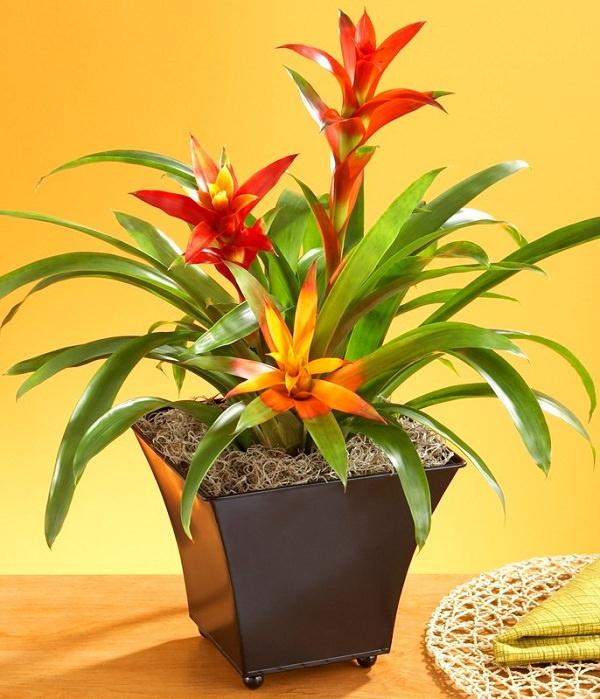
Bromeliad is a perfect plant to grow indoors, most of the varieties of this plant thrive easily indoors. Although it is difficult to make it bloom, there are many varieties that have beautiful foliage that makes an attractive display.
15. Rubber Plant
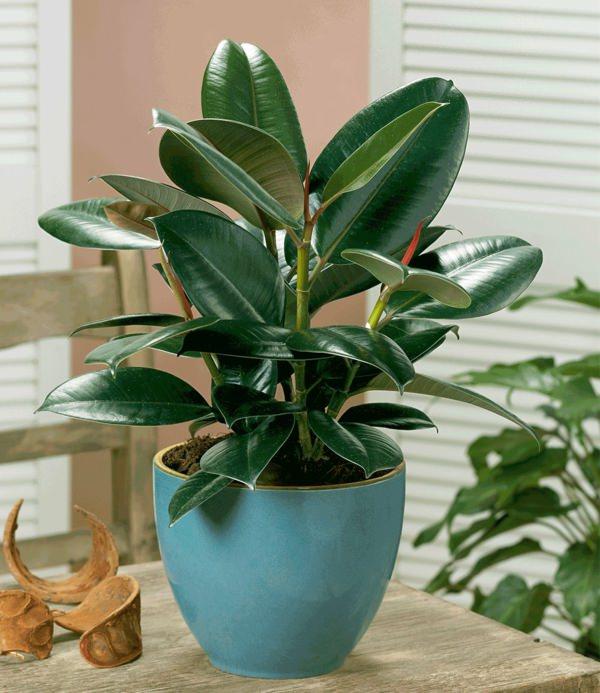
Rubber plant is a large houseplant that can become a focal point to any room. Low maintenance and easy to grow. Keep it in a well-lit position in your home and allow the soil to dry out between watering spells. Besides the ornamental aspect, rubber plant is also an air purifying plant.
Potted houseplants provide a lavish look and can be used to decorate the interior at low cost. Also, they create positive impact and many of them purify the air. But what you’ll do if you don’t have much knowledge about growing plants and the houseplants that are best to grow? Simple! Learn about these 15 Best Houseplants for Beginners! They are easy to grow and tolerate poor conditions.
1. Snake Plant

Snake plant is one of the best plants for the beginners. Easy to grow and hard to kill, it can be grown in low light and need to be watered occasionally. Snake plant also removes toxins from the air– All this makes it a perfect houseplant for beginners.
2. Heartleaf Philodendron

Philodendron scandens is extremely easy to grow and great for beginners. It needs a moderate amount of light and prefers the soil to dry out between watering spells.
3. Spider Plant

One of the most popular houseplants. Its popularity is due to its toughness and the ease of growing and maintenance. The plant can easily adapt to almost any condition. Keep the plant in a bright spot and maintain slight moisture in the soil and it will grow happily.
4. Peace Lily

The peace lily is among the easiest plants to grow indoors. It can tolerate a wide range of lighting conditions, and needs only moderate watering. With graceful curving leaves and white flower that rise up from the dark foliage, peace lily looks exotic and elegant.
5. English Ivy

English Ivy is very hardy and easy to grow. Keep the pot in a spot that receives bright indirect sun and plant it in a container that is wide and shallow rather than narrow and deep.
6. Succulents and Cactus

Succulents and cacti are ideal for those who forget to water and care for plants. They are very adaptable and can survive many adverse conditions.
They need to be placed on a bright spot and a well-drained soil with little water.
7. Lucky Bamboo

Lucky bamboo is not a bamboo, but a plant belongs to Dracaena genus. It is an easy-care houseplant. Just provide it abundant water and it’ll grow well even in indirect light. Protect the plant from cold drafts and provide iron fertilizer occasionally.
8. Jade Plant

Jade plant is a succulent and is probably one of the best houseplants for beginners. When grown indoors, a jade plant can grow up to a size of a small shrub. Keep the plant in a spot that receives partial or indirect sunlight from having a healthy specimen.
9. Cast Iron Plant

As the name suggest, one of the toughest plants that make it ideal for beginners. Cast-iron plant can withstands neglect, low light, low humidity, and a wide range of temperatures. It prefers moist soil.
10. Peperomia

Credit: Houseplants Expert
Another good plant for beginners is Peperomia. Peperomia is small striking houseplant that is available in different colors and shapes. Peperomia likes slightly moist soil and humidity but watering should be reduced in winter.
11. ZZ Plant

This super-tough plant is high resistant to adverse conditions like drought and low light. The plant prefers bright to moderate indirect light and well-drained soil. ZZ plant can do fine without fertilizer, but if you would like, you can fertilize the plant with half strength general fertilizer one to two times a year in the summer months.
12. Pothos (Devil’s Ivy)

Plants of the pothos family are easy to grow and become great houseplants for beginners. This attractive and durable vine prefers bright indirect light and a draft free place. It can grow in low light and needs moist soil.
13. Dracaena

There are many varieties of Dracaena genus that are hardy houseplants, Dracaena marginata, Dracaena fragrans are among the most popular and easy to grow plants. This beautiful houseplant needs occasional pruning and regular watering. Keep the plant away from direct sun and avoid overwatering.
14. Bromeliads

Bromeliad is a perfect plant to grow indoors, most of the varieties of this plant thrive easily indoors. Although it is difficult to make it bloom, there are many varieties that have beautiful foliage that makes an attractive display.
15. Rubber Plant

Rubber plant is a large houseplant that can become a focal point to any room. Low maintenance and easy to grow. Keep it in a well-lit position in your home and allow the soil to dry out between watering spells. Besides the ornamental aspect, rubber plant is also an air purifying plant.
0
2
文章
扭扭
2017年05月23日

Indoor gardening can be a challenge if you’re short of space. And, for your help here’re the 15 Brilliant Vertical Indoor Garden Ideas, by applying a few of these you’ll be able to create more space!1. Vertical Pallet Planter
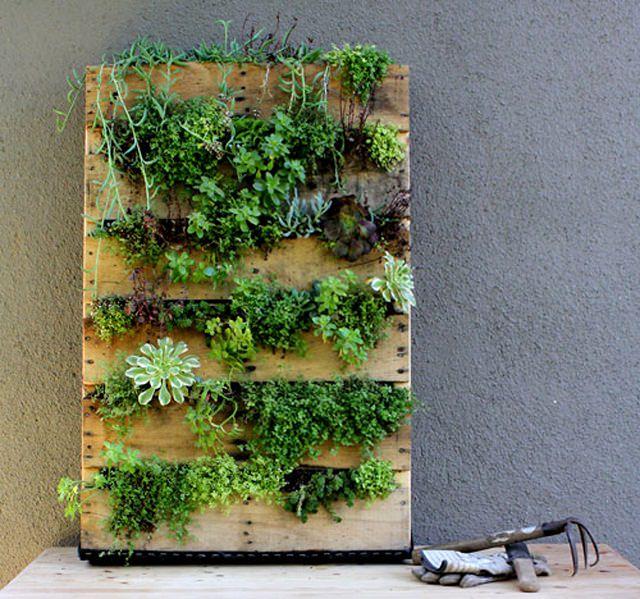
Make a vertical pallet planter to create an adorable indoor garden easily and inexpensively. They’ll provide enough space for growing herbs and succulents without taking a much of floor space. Check out how to make one.
2. Dresser Planter

A bit quirky idea! Use an old dresser to create a stunning indoor garden. Plant some ferns and succulents in its drawers and also place some on top to create a beautiful indoor garden.
3. Indoor Ladder Planter

Previously we wrote a lot about the use of ladder planter in a balcony or rooftop garden. A practical idea! You can apply it to your indoor garden too! An old ladder is perfect to grow multiple house plants in limited space. To make this, simply add several wood planks on ladder steps to create shelves. Then plants your houseplants on it but be sure to place houseplants that have similar light requirements. Here is more on it.
4. DIY Pot Hanger
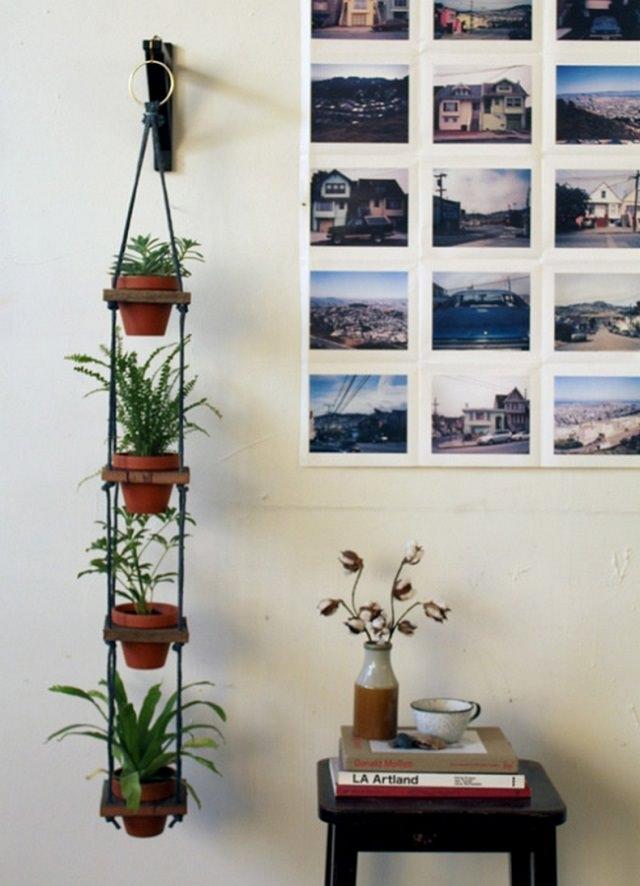
A unique (or say bizarre) way to display your favorite houseplants. This easy project only requires some scrap wood, rope, and a few basic woodworking tools. The best part is that the system makes watering a breeze. All the runoff from the previous pot drips into the plants below, so you only need to water the plant on top and be sure place a saucer under the bottom most pot. Here is the tutorial.
5. TV Stand Vertical Garden
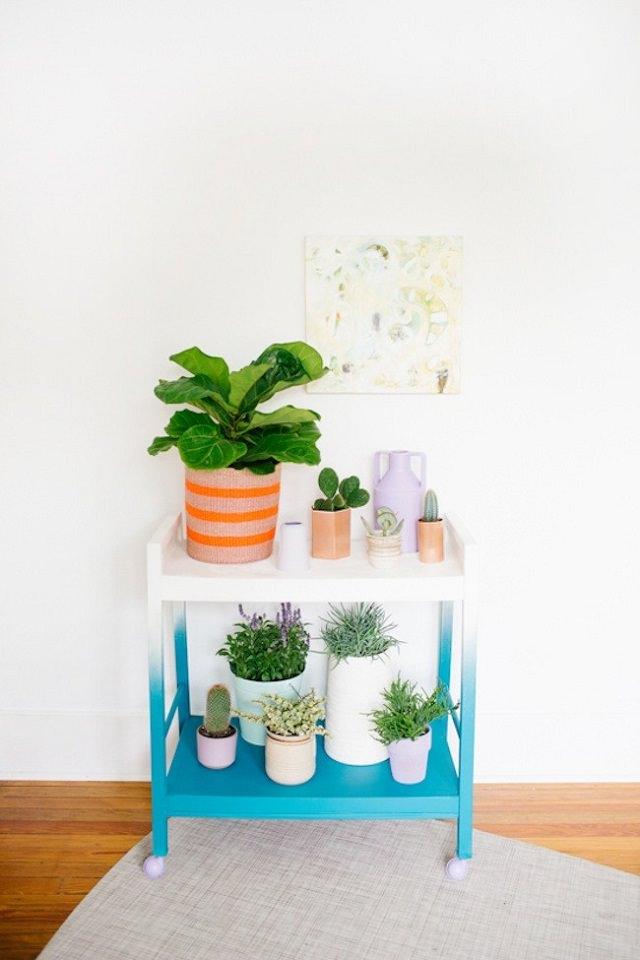
Got an old TV Stand? Make a vertical indoor garden out of it. This is a great way to recycle your old TV stand and transform it to a living beauty. You can either paint it for a fresh new look or use it as it is for a rustic look.
6. Hanging Plastic Bottle Cactus Garden
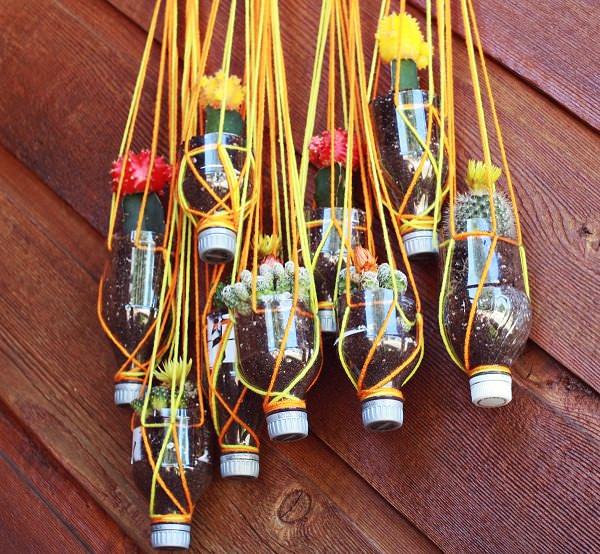
Do you want to create a vertical soda bottle garden? Follow this idea. All that is required is bottles cut in half, cactus plants or succulents, and many colorful threads to get a really cool decorative look. Here you can see the complete tutorial.
7. Shoe Organizer Vertical Garden
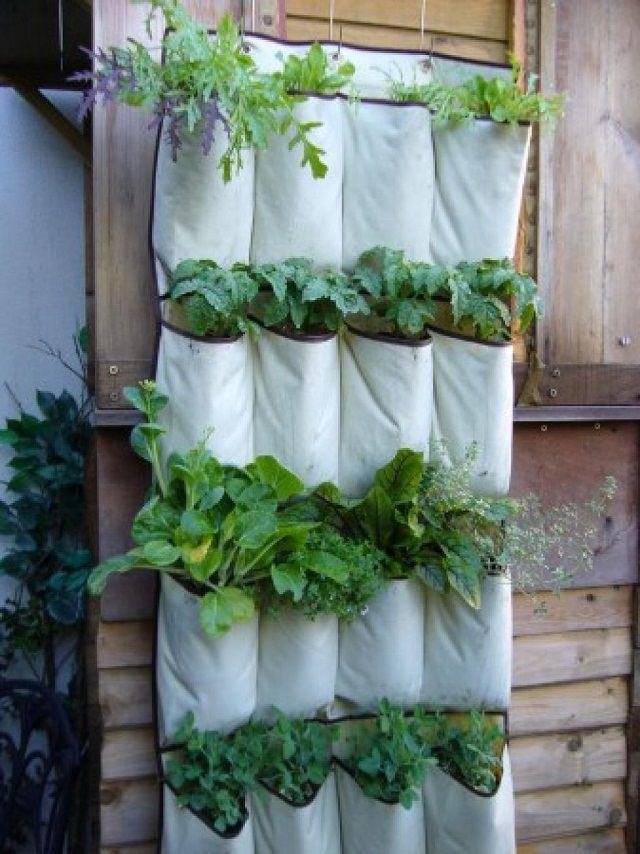
A hanging shoe organizer is perfect for your vertical INDOOR garden. Its pockets are the ideal size for growing individual plants and herbs. Get the DIY instructions here.
8. Vertical Herb Garden

Want to grow herbs but you don’t have space (short of budget too)? Well, even a wooden plank is enough. All you need is some plastic bottles, hooks, nails and hammer and you’re all set to grow your own herbs.
9. Mason Jar Vertical Garden

Don’t throw away those old mason jars, use them creatively to make an indoor herb wall garden. Metal bands and screws hold the jars in place against a scrap piece of wood that is mounted on the wall. Fill in the soil and plant your favorite herbs to use them all year round. Read about more Mason Jar Uses here!
10. Hanging Coconut Planter

Use coconut shells after eating to create this super cute hanging indoor garden. This project is unique, still simple and doesn’t require much. Check out the tutorial here.
11. Pallet Container Holder

Arrange a pallet board and hang several pots on it. It’s easy! And the best part is it will create plenty of vertical space.
12. Vertical Picture Frame Planter
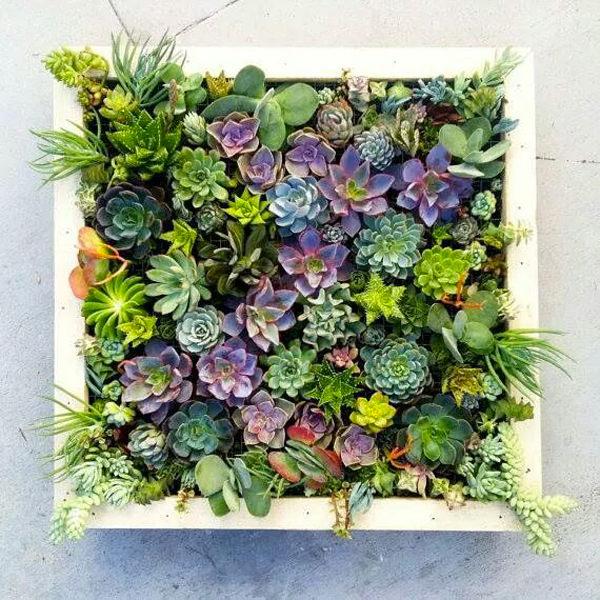
A cool idea for your room if it receives some sun to make it greener, you can hang a wall planter like this in your room. See the step by step tutorial on our website.
13. Vertical Pot Holder From Pallet Planks

Dismantle a pallet board and separate the pallet planks; nail them on to the wall and fix the pots. Simple!
14. Hanging Terracotta Planters

Vertical gardening is a boon for those who’re short of space. A tutorial is available here.
15. Iron Grid Pot Holder
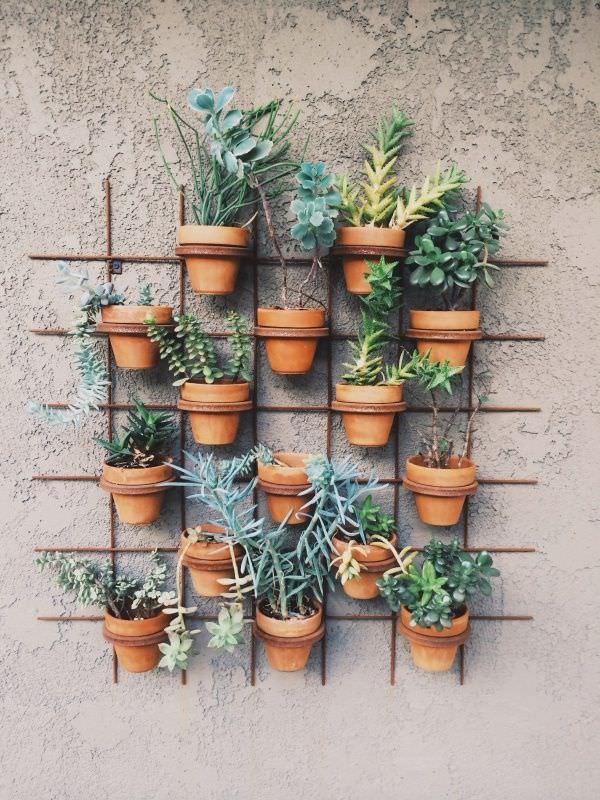
You can make a grid like this by welding the iron rods or weave them by any other method so that you’ll be able to hang the pots. You can paint that too in your favorite color. *The grid can also be made of wood.

Make a vertical pallet planter to create an adorable indoor garden easily and inexpensively. They’ll provide enough space for growing herbs and succulents without taking a much of floor space. Check out how to make one.
2. Dresser Planter

A bit quirky idea! Use an old dresser to create a stunning indoor garden. Plant some ferns and succulents in its drawers and also place some on top to create a beautiful indoor garden.
3. Indoor Ladder Planter

Previously we wrote a lot about the use of ladder planter in a balcony or rooftop garden. A practical idea! You can apply it to your indoor garden too! An old ladder is perfect to grow multiple house plants in limited space. To make this, simply add several wood planks on ladder steps to create shelves. Then plants your houseplants on it but be sure to place houseplants that have similar light requirements. Here is more on it.
4. DIY Pot Hanger

A unique (or say bizarre) way to display your favorite houseplants. This easy project only requires some scrap wood, rope, and a few basic woodworking tools. The best part is that the system makes watering a breeze. All the runoff from the previous pot drips into the plants below, so you only need to water the plant on top and be sure place a saucer under the bottom most pot. Here is the tutorial.
5. TV Stand Vertical Garden

Got an old TV Stand? Make a vertical indoor garden out of it. This is a great way to recycle your old TV stand and transform it to a living beauty. You can either paint it for a fresh new look or use it as it is for a rustic look.
6. Hanging Plastic Bottle Cactus Garden

Do you want to create a vertical soda bottle garden? Follow this idea. All that is required is bottles cut in half, cactus plants or succulents, and many colorful threads to get a really cool decorative look. Here you can see the complete tutorial.
7. Shoe Organizer Vertical Garden

A hanging shoe organizer is perfect for your vertical INDOOR garden. Its pockets are the ideal size for growing individual plants and herbs. Get the DIY instructions here.
8. Vertical Herb Garden

Want to grow herbs but you don’t have space (short of budget too)? Well, even a wooden plank is enough. All you need is some plastic bottles, hooks, nails and hammer and you’re all set to grow your own herbs.
9. Mason Jar Vertical Garden

Don’t throw away those old mason jars, use them creatively to make an indoor herb wall garden. Metal bands and screws hold the jars in place against a scrap piece of wood that is mounted on the wall. Fill in the soil and plant your favorite herbs to use them all year round. Read about more Mason Jar Uses here!
10. Hanging Coconut Planter

Use coconut shells after eating to create this super cute hanging indoor garden. This project is unique, still simple and doesn’t require much. Check out the tutorial here.
11. Pallet Container Holder

Arrange a pallet board and hang several pots on it. It’s easy! And the best part is it will create plenty of vertical space.
12. Vertical Picture Frame Planter

A cool idea for your room if it receives some sun to make it greener, you can hang a wall planter like this in your room. See the step by step tutorial on our website.
13. Vertical Pot Holder From Pallet Planks

Dismantle a pallet board and separate the pallet planks; nail them on to the wall and fix the pots. Simple!
14. Hanging Terracotta Planters

Vertical gardening is a boon for those who’re short of space. A tutorial is available here.
15. Iron Grid Pot Holder

You can make a grid like this by welding the iron rods or weave them by any other method so that you’ll be able to hang the pots. You can paint that too in your favorite color. *The grid can also be made of wood.
1
0
文章
Colorful
2017年05月23日

Love the color purple? Then grow these 15 GORGEOUS purple houseplants known for their colorful foliage and warm texture!1. Purple Oxalis
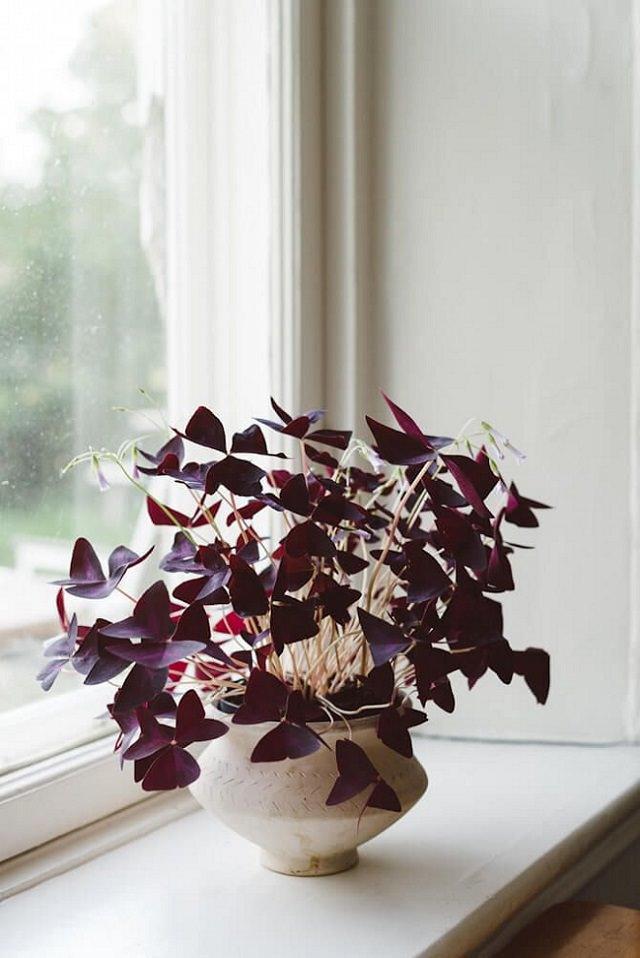
Native to Brazil, Oxalis plants display unique, pinwheel foliage and a wealth of starry blossoms. Some varieties produce purple leaves or foliage with deeper accent markings. Its delicate foliage and dainty flowers make it an ideal choice for containers and indoors alike. The tiny, triangular leaflets close at night, which make it a fun plant to have around the house.
2. Coleus
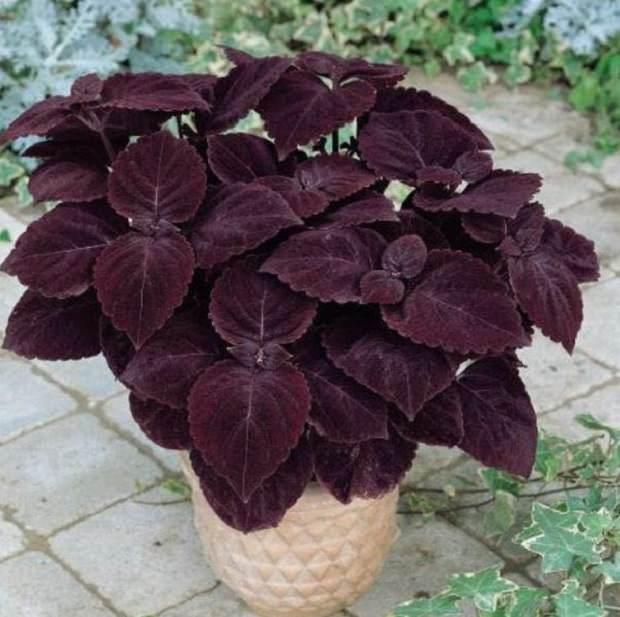
Coleus is a beautiful, showy plant that is available in various colors and styles. Mostly used as an annual for outdoor gardens, it is super easy to grow as an indoor plant as well. The vibrancy of its colors comes from receiving an adequate amount of sunlight. The more the light, the more vivid the colors. However, shade does allow the colors to form as well, though they will be a tad subdued. Coleus is remarkably easy to propagate. The eye-catchy, fancy leaves can liven up a dull drawing room, while the compact structure does justice to space-constrained corners well.
3. Prayer Plant
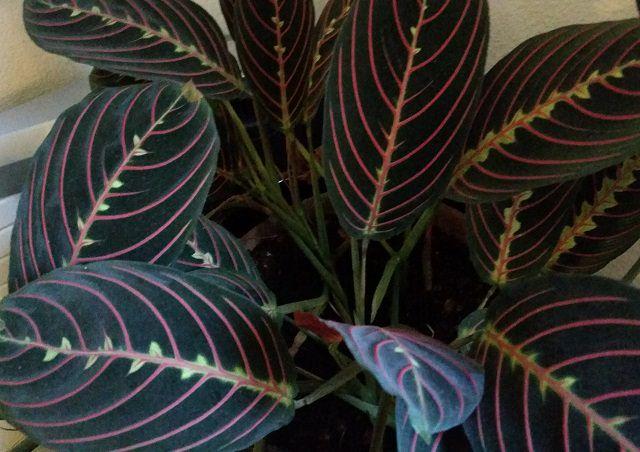
The prayer plant, with its unusual, purplish brown leaf markings is a fun little plant to have around the house. Also known as rabbit tracks, it has two different varieties, the green, and the red one. The latter has bold red leaf veins alongside the markings. Leaves close at night, thereby creating the appearance of praying hands. Prayer plant thrives well on moderately high humidity and uniformly watered soil. However, it appreciates remaining on a drier side in winter.
4. Sweet Caroline ‘Purple’ Potato Vine

We love this! One of the most gorgeous and versatile plants around for CONTAINER GARDENERS, sweet potato vine, performs well in both partial sun and shade and looks pretty in container gardens, borders, garden beds and landscapes. The plant is mainly loved for its brilliant foliage that is available in different colors of lime, purple, bronze, black or copper. And since its beauty comes from its leaf, the plant can be enjoyed all year long without having to wait for the blooms to show up. Sweet potato vine grows best in the moist and well-drained soil. It is remarkably flexible regarding light requirements.
5. Wandering Jew

A unique, easy to grow houseplant, the Wandering Jew is a popular houseplant that is both easy to grow and looks amazing in a hanging basket as well as in a topiary form. The most widely available variety of this vine has leaves marked with characteristic olive and silver markings on the top and a dark purplish maroon color on the undersides. Some varieties flaunt a purplish color on both surfaces of the leaves. Wandering Jew thrives well on medium to bright low light and uniformly-watered soil. You can grow this plant from stem cuttings stuck in water or a moist potting soil. It’s recommended to allow the soil to dry in between watering spells.
6. Ti Plant

Ti plant is an astonishing red-purple colored houseplant featuring flamboyantly colored foliage and an elegant appeal; the ti plant is a perfect choice for adding a pop of color, style, and drama to a well-lit corner of your room. Most varieties have strap-like leaves variegated with bright streaks of different colors of hot pink, white, cream, or deeper shades of purple. Ti plant is picky about sunlight and likes to be in a spot that receives a partial sun.
7. Rex Begonia
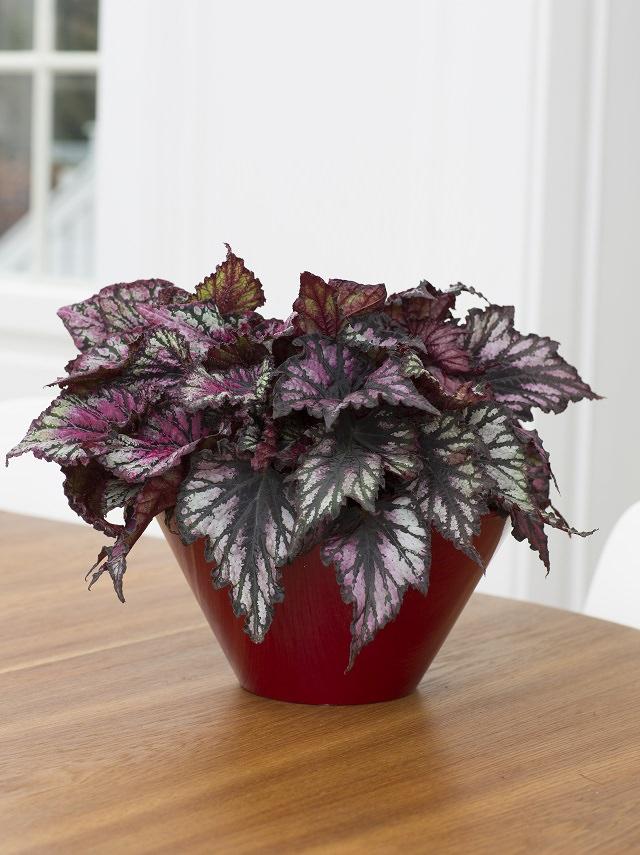
Rex begonia plants are cherished for their dramatically colored and textured foliage. The leaves come in a broad spectrum of colors, shapes, and stripes. While the flowers are insignificant, the unique leaf shapes and attractive color combinations of silver, red, purple, white and pink pretty much makes up for it. Rex begonia mostly enjoys shade gardens, which makes it apt for indoor gardening. Soggy soil and excessive use of fertilizers lead to instant rotting, while prolonged wet leaves make them susceptible to infection. If you keep these in mind, caring for your Rex begonia plant will be a breeze.
8. Purple Passion (Gynura Aurantiaca)
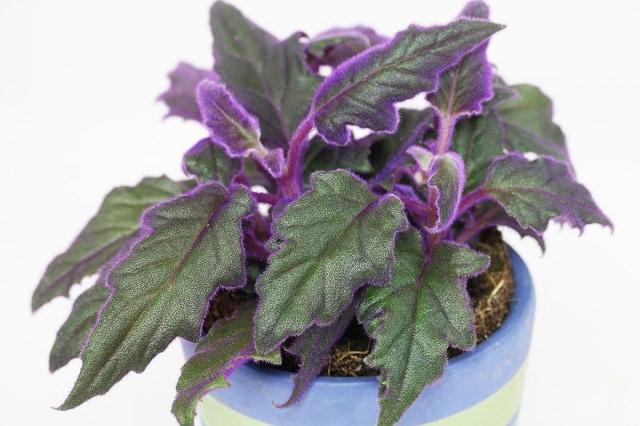
This lovely houseplant has fuzzy green foliage with a dab of purple hairs and edges. Grow it in any neutral colored houseplant, and you’ll see how it’ll stand out from the other houseplants. Its characteristic purple sheen comes when it is touched by a fleck of sunlight. Purple passion has an upright habit when young and becomes more vine-like and spreading as it matures. This makes it a perfect choice for adorning hanging baskets and small trellises alike. The plant enjoys the bright light and evenly moist soil.
9. Caladium

Caladiums are beautiful tropical plants with big, wafer-thin leaves having varying patterns in reds, pink, purple and cream. The brilliant foliage of this plant is its USP, as it is available in unusual shapes like hearts, lances or arrows, as well as eye-catchy color combinations of red, pink, rose and white. Being a shade plant, it doesn’t mind growing indoors, though it requires a minimum of 3-4 hours of filtered light each day.
10. Waffle Plant
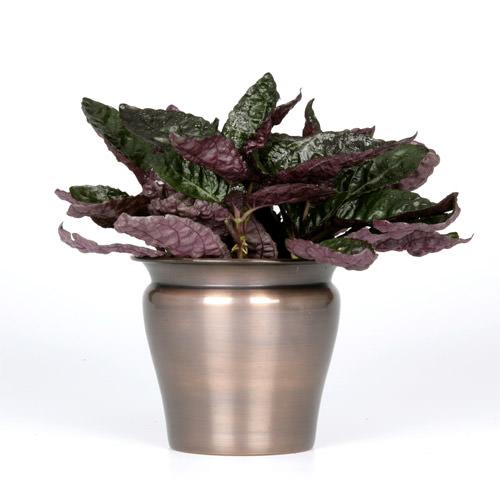
The waffle plant is a beautiful tiny houseplant with colorful foliage having a metallic tone in purple color, the striking appearance, which makes it an excellent addition to your home or office. Its small stature makes it ideal for decorating crammed-up desks or countertops, while its low growing nature makes it suitable for use as a groundcover underneath larger indoor plants like ficus trees. Waffle plant benefits from medium to bright light indoors. Remember, if it doesn’t get adequate sunlight, it may lose its vibrant purple coloring. However, direct light is a hazard as the leaves may bleach and undergo sunburn. Accent the waffle plant’s brilliant foliage with a terracotta container for a classic appeal.
11. Red Aglaonema
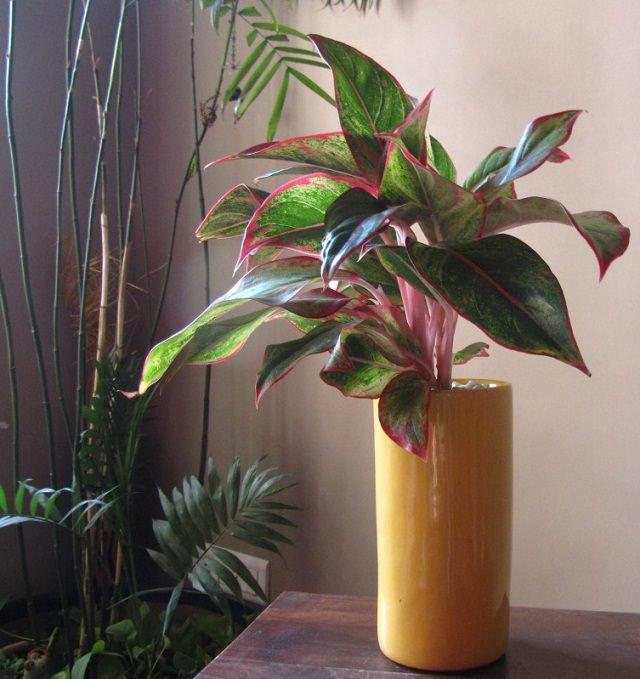
Red aglaonema is a spectacular Chinese evergreen plant with stunning, purple or red-tinted leaves. One of the easiest houseplants to grow, red aglaonema, is a new and stylish entree to the world of houseplants. This beauty flaunts dark green leaves marked elegantly with bright red, purple or pink stripes. Its colorful foliage makes it apt for decorating desks, tabletops, coffee tables as well as side tables in bedrooms. You can also consider using it as a substitute for poinsettia this season. The long-lived houseplant retains its color all through the year and demands little care in the process.
12. Calathea
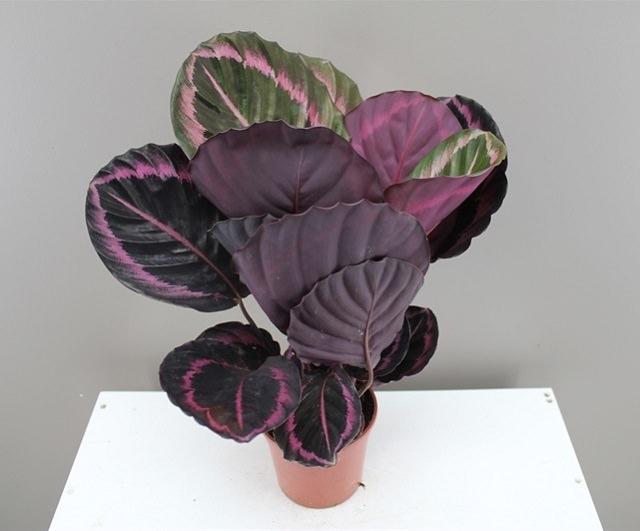
The calathea is one of the most beautiful houseplants that has the potential to light up any room with colorful accents. With a special marking of stark white veins against red, purple, green and cream leaves, the calathea lends an exciting and fashionable touch to your home. Most varieties have reddish purple color on the undersides of leaves, which makes them attractive when viewed from both above or below.
13. Iron-Cross Begonia
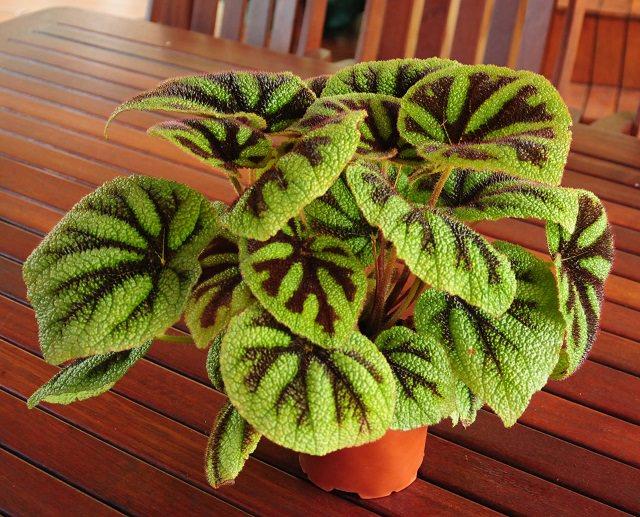
This beautiful New Guinea species is a must for you if you love growing unique indoor plants. Its leaves sport wide, chocolate-brown markings which stand out well against the dark green backdrop and radiate all the way to the leaf margins, thereby resembling the German iron cross. The beautiful coloration set against solid green with a coarse, pebbled texture makes for a very royal presence that is sure to liven up your home like none other. The plant prefers humid conditions, though you are best off cutting back on the water amount if you notice yellowing or browning of the leaves.
14. Rubber Tree (Ficus elastica)
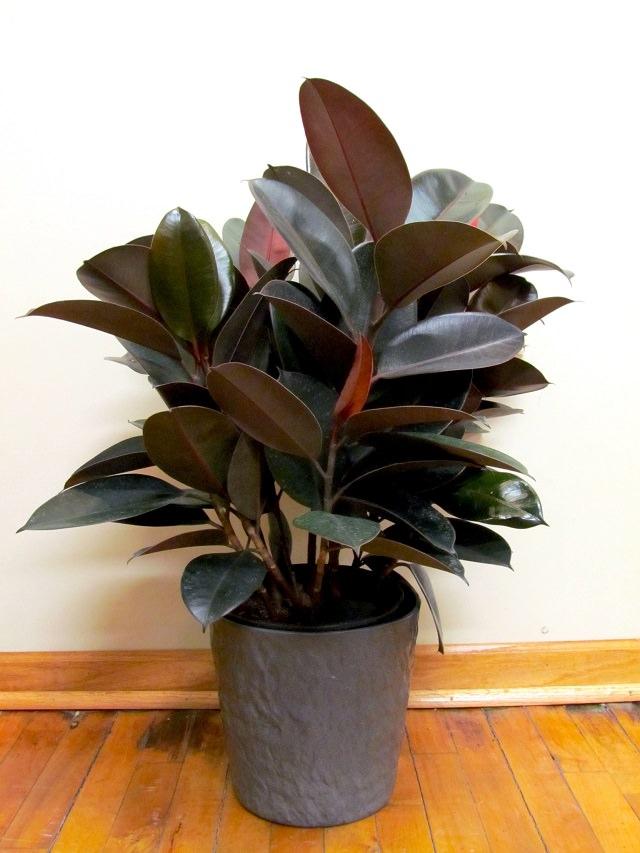
The mention of rubber tree immediately conjures up images of latex oozing out from barks. True that but it is one of the most popular houseplants today and why not it looks impressive indoors and cleanse the air too. Its leaves appear dark purple when mature, and bright red when young and opening. Learn how to grow a rubber tree houseplant here!
Also Read: Plants for Restful Sleep
15. Silver Squill

Contrary to its name, silver squill is a tough little plant. Hailing from the Cape Province of South Africa, it grows in dry habitats and stores moisture in its succulent, bulb-like stems as an adaptation tactic against the moisture-deprived soil. With its unique structure and colorful foliage, it becomes an unusual houseplant, which is sure to attract plenty of eyeballs. The plant derives its name from the lovely, silver-colored polka dots on leaves and the rich purple undersides of the stems. It’s easy to care as well, provided you grow them in the shade.

Native to Brazil, Oxalis plants display unique, pinwheel foliage and a wealth of starry blossoms. Some varieties produce purple leaves or foliage with deeper accent markings. Its delicate foliage and dainty flowers make it an ideal choice for containers and indoors alike. The tiny, triangular leaflets close at night, which make it a fun plant to have around the house.
2. Coleus

Coleus is a beautiful, showy plant that is available in various colors and styles. Mostly used as an annual for outdoor gardens, it is super easy to grow as an indoor plant as well. The vibrancy of its colors comes from receiving an adequate amount of sunlight. The more the light, the more vivid the colors. However, shade does allow the colors to form as well, though they will be a tad subdued. Coleus is remarkably easy to propagate. The eye-catchy, fancy leaves can liven up a dull drawing room, while the compact structure does justice to space-constrained corners well.
3. Prayer Plant

The prayer plant, with its unusual, purplish brown leaf markings is a fun little plant to have around the house. Also known as rabbit tracks, it has two different varieties, the green, and the red one. The latter has bold red leaf veins alongside the markings. Leaves close at night, thereby creating the appearance of praying hands. Prayer plant thrives well on moderately high humidity and uniformly watered soil. However, it appreciates remaining on a drier side in winter.
4. Sweet Caroline ‘Purple’ Potato Vine

We love this! One of the most gorgeous and versatile plants around for CONTAINER GARDENERS, sweet potato vine, performs well in both partial sun and shade and looks pretty in container gardens, borders, garden beds and landscapes. The plant is mainly loved for its brilliant foliage that is available in different colors of lime, purple, bronze, black or copper. And since its beauty comes from its leaf, the plant can be enjoyed all year long without having to wait for the blooms to show up. Sweet potato vine grows best in the moist and well-drained soil. It is remarkably flexible regarding light requirements.
5. Wandering Jew

A unique, easy to grow houseplant, the Wandering Jew is a popular houseplant that is both easy to grow and looks amazing in a hanging basket as well as in a topiary form. The most widely available variety of this vine has leaves marked with characteristic olive and silver markings on the top and a dark purplish maroon color on the undersides. Some varieties flaunt a purplish color on both surfaces of the leaves. Wandering Jew thrives well on medium to bright low light and uniformly-watered soil. You can grow this plant from stem cuttings stuck in water or a moist potting soil. It’s recommended to allow the soil to dry in between watering spells.
6. Ti Plant

Ti plant is an astonishing red-purple colored houseplant featuring flamboyantly colored foliage and an elegant appeal; the ti plant is a perfect choice for adding a pop of color, style, and drama to a well-lit corner of your room. Most varieties have strap-like leaves variegated with bright streaks of different colors of hot pink, white, cream, or deeper shades of purple. Ti plant is picky about sunlight and likes to be in a spot that receives a partial sun.
7. Rex Begonia

Rex begonia plants are cherished for their dramatically colored and textured foliage. The leaves come in a broad spectrum of colors, shapes, and stripes. While the flowers are insignificant, the unique leaf shapes and attractive color combinations of silver, red, purple, white and pink pretty much makes up for it. Rex begonia mostly enjoys shade gardens, which makes it apt for indoor gardening. Soggy soil and excessive use of fertilizers lead to instant rotting, while prolonged wet leaves make them susceptible to infection. If you keep these in mind, caring for your Rex begonia plant will be a breeze.
8. Purple Passion (Gynura Aurantiaca)

This lovely houseplant has fuzzy green foliage with a dab of purple hairs and edges. Grow it in any neutral colored houseplant, and you’ll see how it’ll stand out from the other houseplants. Its characteristic purple sheen comes when it is touched by a fleck of sunlight. Purple passion has an upright habit when young and becomes more vine-like and spreading as it matures. This makes it a perfect choice for adorning hanging baskets and small trellises alike. The plant enjoys the bright light and evenly moist soil.
9. Caladium

Caladiums are beautiful tropical plants with big, wafer-thin leaves having varying patterns in reds, pink, purple and cream. The brilliant foliage of this plant is its USP, as it is available in unusual shapes like hearts, lances or arrows, as well as eye-catchy color combinations of red, pink, rose and white. Being a shade plant, it doesn’t mind growing indoors, though it requires a minimum of 3-4 hours of filtered light each day.
10. Waffle Plant

The waffle plant is a beautiful tiny houseplant with colorful foliage having a metallic tone in purple color, the striking appearance, which makes it an excellent addition to your home or office. Its small stature makes it ideal for decorating crammed-up desks or countertops, while its low growing nature makes it suitable for use as a groundcover underneath larger indoor plants like ficus trees. Waffle plant benefits from medium to bright light indoors. Remember, if it doesn’t get adequate sunlight, it may lose its vibrant purple coloring. However, direct light is a hazard as the leaves may bleach and undergo sunburn. Accent the waffle plant’s brilliant foliage with a terracotta container for a classic appeal.
11. Red Aglaonema

Red aglaonema is a spectacular Chinese evergreen plant with stunning, purple or red-tinted leaves. One of the easiest houseplants to grow, red aglaonema, is a new and stylish entree to the world of houseplants. This beauty flaunts dark green leaves marked elegantly with bright red, purple or pink stripes. Its colorful foliage makes it apt for decorating desks, tabletops, coffee tables as well as side tables in bedrooms. You can also consider using it as a substitute for poinsettia this season. The long-lived houseplant retains its color all through the year and demands little care in the process.
12. Calathea

The calathea is one of the most beautiful houseplants that has the potential to light up any room with colorful accents. With a special marking of stark white veins against red, purple, green and cream leaves, the calathea lends an exciting and fashionable touch to your home. Most varieties have reddish purple color on the undersides of leaves, which makes them attractive when viewed from both above or below.
13. Iron-Cross Begonia

This beautiful New Guinea species is a must for you if you love growing unique indoor plants. Its leaves sport wide, chocolate-brown markings which stand out well against the dark green backdrop and radiate all the way to the leaf margins, thereby resembling the German iron cross. The beautiful coloration set against solid green with a coarse, pebbled texture makes for a very royal presence that is sure to liven up your home like none other. The plant prefers humid conditions, though you are best off cutting back on the water amount if you notice yellowing or browning of the leaves.
14. Rubber Tree (Ficus elastica)

The mention of rubber tree immediately conjures up images of latex oozing out from barks. True that but it is one of the most popular houseplants today and why not it looks impressive indoors and cleanse the air too. Its leaves appear dark purple when mature, and bright red when young and opening. Learn how to grow a rubber tree houseplant here!
Also Read: Plants for Restful Sleep
15. Silver Squill

Contrary to its name, silver squill is a tough little plant. Hailing from the Cape Province of South Africa, it grows in dry habitats and stores moisture in its succulent, bulb-like stems as an adaptation tactic against the moisture-deprived soil. With its unique structure and colorful foliage, it becomes an unusual houseplant, which is sure to attract plenty of eyeballs. The plant derives its name from the lovely, silver-colored polka dots on leaves and the rich purple undersides of the stems. It’s easy to care as well, provided you grow them in the shade.
2
1
文章
stone
2017年05月22日
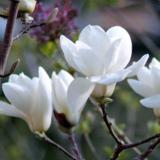
#彩色马蹄莲 与#白色马蹄莲 在栽培管理上没有太大的区别。生长适温均为15℃至25℃,开花期间,日间温度为16℃至19℃,白色品种夜间温度不低于13℃,而有色品种应不低于16℃。若温度高于25℃或低于5℃,则植株被迫进入休眠。它性喜温暖湿润和阳光充足的环境,不耐寒冷和干旱。
彩色马蹄莲植株开完花后,浇水量要逐渐减少,叶变黄枯萎时,要完全停止浇水。生长季节,每半月施稀薄液肥一次,当花莛抽出后,要增加到每周一次,直到花期结束为止。
家庭盆栽彩色马蹄莲,可施用多元缓释复合肥颗粒,也可用0.2%的尿素加0.1%的磷酸二氢钾混合液。栽培用土,可用园土、腐叶土、泥炭土按2∶2∶1 混合,再加入少量的多元复合肥颗粒。
家庭养护马蹄莲时,还应注意以下三点:一是它的心叶忌水湿,平时浇水不留心,使污水滴流入叶心内,易引起软腐病;二是施肥时要从盆缘施入,切忌肥液淋入叶柄内或溅入株心,否则易引起黄叶或腐烂;三是马蹄莲怕烟熏,否则会引起叶片发黄和花苞脱落。
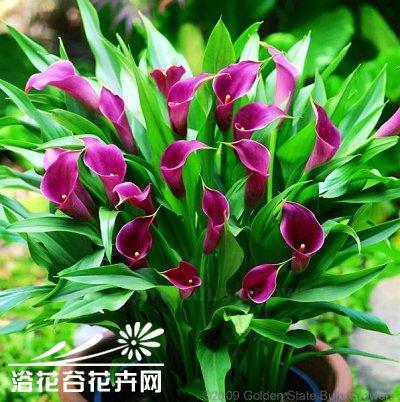
盆栽彩色马蹄莲的栽培技术如下:
上盆要领
预处理:种球到货后,可用赤霉素或勃宁激动素来增加开花数量,可用50-100ppm赤霉素或勃宁激动素浸泡5-10分钟,取出晒干,赤霉素的处理对花梗的长度影响不大,但会使叶片变得狭长,影响观赏价值;500ppm百菌清加500ppm瑞毒霉浸2分钟取出晒干,这一步骤对根茎腐病和软腐病的防治特别重要;在种植时生长点向上;覆土约5厘米后厚;种后淋透清水。
水分管理
块茎需要很多的水分,在生长早期要有规律的浇水,但不要让土太湿,等叶抽出来进入旺盛生长期时注意见干见湿。一般早上浇水,如果天气太热就需要在下午浇水。
使用滴灌能很好的保持水分,在有风的天气下更适于使用。如果要用喷雾灌溉的话,喷头的距离要精确,以保证水量的均匀分布。喷头必须比植株高1米,喷灌系统必须要有足够的压力(至少4千克压力)。植株在水分过多或过少时抗病性会降低,尤其对软腐病抗性会降低。
肥料管理
彩色马蹄莲属于需肥不高的花卉,不同的类型要求不同的肥料水平。用NPK比为20-20-20或12:10:10的均衡肥料,以100ppm的氮浓度每周施一次或200ppm的氮浓度每周施两次左右。
矮化处理
盆栽彩色马蹄莲品种通常高30-50厘米,可根据种植盆的规格和市场需求来决定是否进行矮化处理。嘧啶醇和多效唑对彩色马蹄莲是有效的,矮化处理对叶片的长度有明显的控制,但对花梗的抽长影响不太明显。
病虫害防治
在整个生长季节必须有详细的打药计划,主要用内吸杀虫剂。彩色马蹄莲的主要虫害是蓟马和蚜虫,控制它们特别重要,因为蚜虫能传播病毒。
出芽后就应该开始喷药,每7-10天喷一次,开花结束后,可每3周喷药一次。下面这些药比较适合用在彩色马蹄莲上:地亚农(二嗪磷)、敌杀死、马扑立克(氟胺氰菊脂)、乙酰甲胺磷和敌死通等粒状药(内吸杀菌剂)。这些药在潮湿条件下开始起作用,植株从根部吸收后向上传导,能防治蚜虫和蓟马。这些药品都是危险品,使用时要特别小心,选择多种农药混合使用或轮换使用可防止害虫产生抗药性。注意整个植株都必须喷上药。
种球病害控制
彩色马蹄莲容易被病霉菌和丝核菌从根部侵染,且只有在侵染两周后地上部分才会表现出来,表现为叶片发黄、萎蔫及卷曲等不良症状。如果在潮湿状态下,很容易发生细菌软腐病。在栽植后每2-4周使用根菌清和瑞毒霉,浓度为1升水用0.5克根菌清和0.5克瑞毒霉,灌根一次。
腐霉菌可用呋霜灵控制,但要确保对植株无害,在喷后一周内不要喷杀虫剂。病菌能通过灌溉及地面污染的水传染,要严格检查水源,如有污染要采取针对性处理。
花期病害控制
在湿度大或多雨的季节,花头上有病斑是很常见的。易感染的病害有灰霉病和交链孢萎蔫病。每7-10天喷一次保护性杀菌剂(如百菌清、克菌丹、福美双、代森锰锌和甲苯氟磺胺等)以确保花上有药物残留。
当病害较为严重时,要及时喷治疗性杀菌剂(要能耐小雨,并能在晚上较冷时使用)。这种杀菌剂包括根菌清、异菌脲、咪鲜胺施保克。但一种要每一季只能用2-3次,在湿季下雨前2-3天及时喷药。除了在花期,每10天喷一次可杀得(氢氧化铜)能起到很好的保护效果(100克/100升)。
细菌性软腐病在彩色马蹄莲上是特别严重的问题。好的种球管理将有助于控制细菌性软腐病的发生,尤其是在起球及贮存时应特别注意。当土壤温度高于23℃时植株易感染病菌。
在生长阶段内,当植株抗性减弱时易感染软腐病。许多因素将导致植株抗性减弱,如最初的病原菌侵染、过湿或太干、药害及肥烧、过高的土壤盐分、芽前除草剂的伤害、过高的土壤温度或不适的气候条件。一旦染上细菌性软腐病,病菌将很难根除,可用有保护性的“BTAPO”浇灌,并定期叶面喷洒可杀得(氢氧化铜)。研究表明,抗性弱及细菌性软腐病是彩色马蹄莲栽培上的主要两个问题。细菌性软腐病在高湿、高温条件下极易发生,现在有许多实践经验可用来避免这些问题的发生:
使用排水良好、含氧量高的栽培土壤或基质,因为细菌性软腐病为兼气性厌氧性细菌;
种植密度不要太疏,以利用叶子遮荫,减低土壤温度;
保持土壤微酸性和块茎的高钙浓度,使用石膏可提高钙含量,但不提高pH值,避免人和动物伤害种球。
马蹄莲植株花谢后,应逐渐减少浇水量,至4月下旬搬至室外,放置在略有蔽荫处养护,每天浇水一次,并向花盆附近地面洒水,借以增加空气湿度。6月以后,叶片逐渐枯黄进入休眠期,这时要剪去枯叶,控制浇水,停止施肥,将花盆搬放到通风凉爽处,促使其休眠。至秋季天气转凉后再将块茎从花盆内倒出,取出大的块茎,用新鲜肥沃的培养土重新栽植,待块茎萌发出叶时,再逐渐增加浇水量,同时恢复施肥,便可使其继续开花。
彩色马蹄莲植株开完花后,浇水量要逐渐减少,叶变黄枯萎时,要完全停止浇水。生长季节,每半月施稀薄液肥一次,当花莛抽出后,要增加到每周一次,直到花期结束为止。
家庭盆栽彩色马蹄莲,可施用多元缓释复合肥颗粒,也可用0.2%的尿素加0.1%的磷酸二氢钾混合液。栽培用土,可用园土、腐叶土、泥炭土按2∶2∶1 混合,再加入少量的多元复合肥颗粒。
家庭养护马蹄莲时,还应注意以下三点:一是它的心叶忌水湿,平时浇水不留心,使污水滴流入叶心内,易引起软腐病;二是施肥时要从盆缘施入,切忌肥液淋入叶柄内或溅入株心,否则易引起黄叶或腐烂;三是马蹄莲怕烟熏,否则会引起叶片发黄和花苞脱落。

盆栽彩色马蹄莲的栽培技术如下:
上盆要领
预处理:种球到货后,可用赤霉素或勃宁激动素来增加开花数量,可用50-100ppm赤霉素或勃宁激动素浸泡5-10分钟,取出晒干,赤霉素的处理对花梗的长度影响不大,但会使叶片变得狭长,影响观赏价值;500ppm百菌清加500ppm瑞毒霉浸2分钟取出晒干,这一步骤对根茎腐病和软腐病的防治特别重要;在种植时生长点向上;覆土约5厘米后厚;种后淋透清水。
水分管理
块茎需要很多的水分,在生长早期要有规律的浇水,但不要让土太湿,等叶抽出来进入旺盛生长期时注意见干见湿。一般早上浇水,如果天气太热就需要在下午浇水。
使用滴灌能很好的保持水分,在有风的天气下更适于使用。如果要用喷雾灌溉的话,喷头的距离要精确,以保证水量的均匀分布。喷头必须比植株高1米,喷灌系统必须要有足够的压力(至少4千克压力)。植株在水分过多或过少时抗病性会降低,尤其对软腐病抗性会降低。
肥料管理
彩色马蹄莲属于需肥不高的花卉,不同的类型要求不同的肥料水平。用NPK比为20-20-20或12:10:10的均衡肥料,以100ppm的氮浓度每周施一次或200ppm的氮浓度每周施两次左右。
矮化处理
盆栽彩色马蹄莲品种通常高30-50厘米,可根据种植盆的规格和市场需求来决定是否进行矮化处理。嘧啶醇和多效唑对彩色马蹄莲是有效的,矮化处理对叶片的长度有明显的控制,但对花梗的抽长影响不太明显。
病虫害防治
在整个生长季节必须有详细的打药计划,主要用内吸杀虫剂。彩色马蹄莲的主要虫害是蓟马和蚜虫,控制它们特别重要,因为蚜虫能传播病毒。
出芽后就应该开始喷药,每7-10天喷一次,开花结束后,可每3周喷药一次。下面这些药比较适合用在彩色马蹄莲上:地亚农(二嗪磷)、敌杀死、马扑立克(氟胺氰菊脂)、乙酰甲胺磷和敌死通等粒状药(内吸杀菌剂)。这些药在潮湿条件下开始起作用,植株从根部吸收后向上传导,能防治蚜虫和蓟马。这些药品都是危险品,使用时要特别小心,选择多种农药混合使用或轮换使用可防止害虫产生抗药性。注意整个植株都必须喷上药。
种球病害控制
彩色马蹄莲容易被病霉菌和丝核菌从根部侵染,且只有在侵染两周后地上部分才会表现出来,表现为叶片发黄、萎蔫及卷曲等不良症状。如果在潮湿状态下,很容易发生细菌软腐病。在栽植后每2-4周使用根菌清和瑞毒霉,浓度为1升水用0.5克根菌清和0.5克瑞毒霉,灌根一次。
腐霉菌可用呋霜灵控制,但要确保对植株无害,在喷后一周内不要喷杀虫剂。病菌能通过灌溉及地面污染的水传染,要严格检查水源,如有污染要采取针对性处理。
花期病害控制
在湿度大或多雨的季节,花头上有病斑是很常见的。易感染的病害有灰霉病和交链孢萎蔫病。每7-10天喷一次保护性杀菌剂(如百菌清、克菌丹、福美双、代森锰锌和甲苯氟磺胺等)以确保花上有药物残留。
当病害较为严重时,要及时喷治疗性杀菌剂(要能耐小雨,并能在晚上较冷时使用)。这种杀菌剂包括根菌清、异菌脲、咪鲜胺施保克。但一种要每一季只能用2-3次,在湿季下雨前2-3天及时喷药。除了在花期,每10天喷一次可杀得(氢氧化铜)能起到很好的保护效果(100克/100升)。
细菌性软腐病在彩色马蹄莲上是特别严重的问题。好的种球管理将有助于控制细菌性软腐病的发生,尤其是在起球及贮存时应特别注意。当土壤温度高于23℃时植株易感染病菌。
在生长阶段内,当植株抗性减弱时易感染软腐病。许多因素将导致植株抗性减弱,如最初的病原菌侵染、过湿或太干、药害及肥烧、过高的土壤盐分、芽前除草剂的伤害、过高的土壤温度或不适的气候条件。一旦染上细菌性软腐病,病菌将很难根除,可用有保护性的“BTAPO”浇灌,并定期叶面喷洒可杀得(氢氧化铜)。研究表明,抗性弱及细菌性软腐病是彩色马蹄莲栽培上的主要两个问题。细菌性软腐病在高湿、高温条件下极易发生,现在有许多实践经验可用来避免这些问题的发生:
使用排水良好、含氧量高的栽培土壤或基质,因为细菌性软腐病为兼气性厌氧性细菌;
种植密度不要太疏,以利用叶子遮荫,减低土壤温度;
保持土壤微酸性和块茎的高钙浓度,使用石膏可提高钙含量,但不提高pH值,避免人和动物伤害种球。
马蹄莲植株花谢后,应逐渐减少浇水量,至4月下旬搬至室外,放置在略有蔽荫处养护,每天浇水一次,并向花盆附近地面洒水,借以增加空气湿度。6月以后,叶片逐渐枯黄进入休眠期,这时要剪去枯叶,控制浇水,停止施肥,将花盆搬放到通风凉爽处,促使其休眠。至秋季天气转凉后再将块茎从花盆内倒出,取出大的块茎,用新鲜肥沃的培养土重新栽植,待块茎萌发出叶时,再逐渐增加浇水量,同时恢复施肥,便可使其继续开花。
0
1




